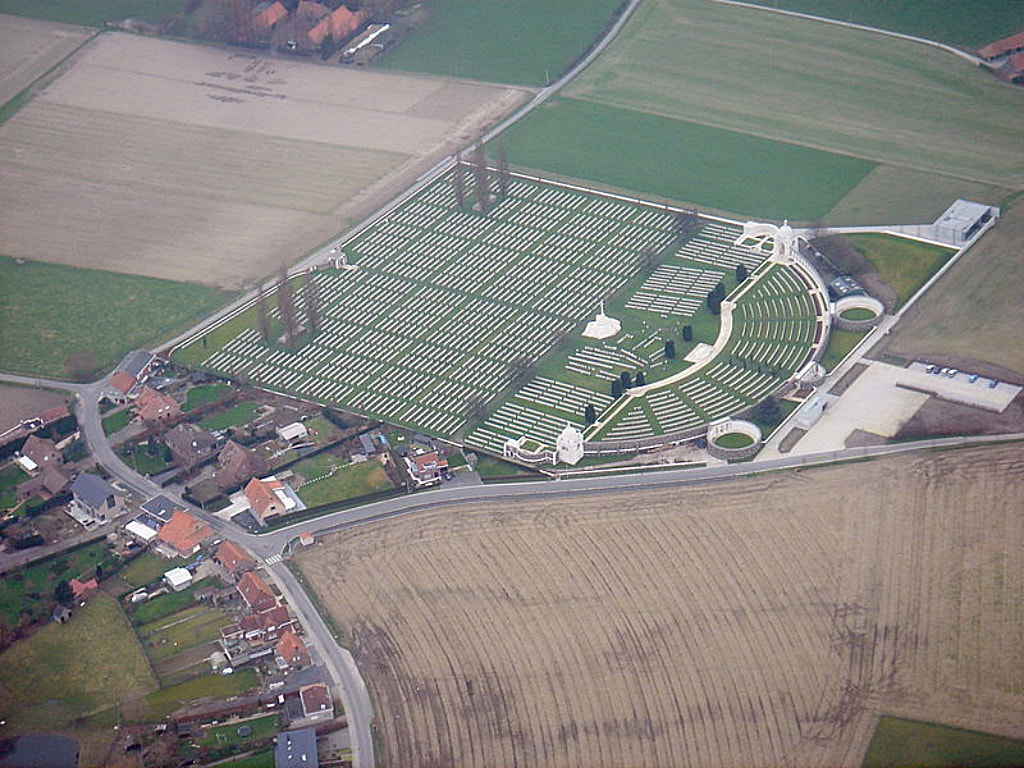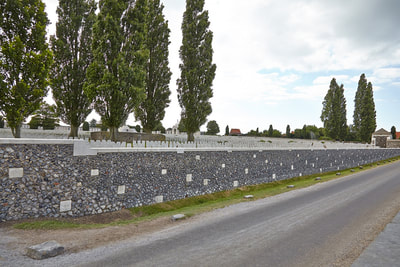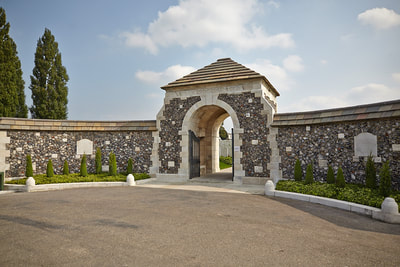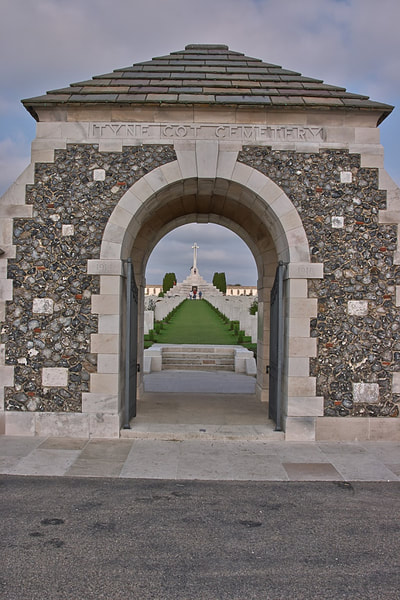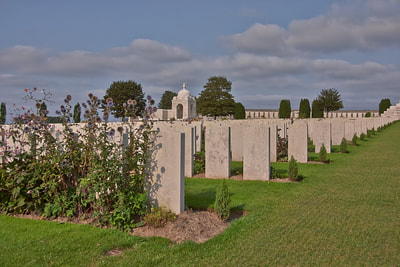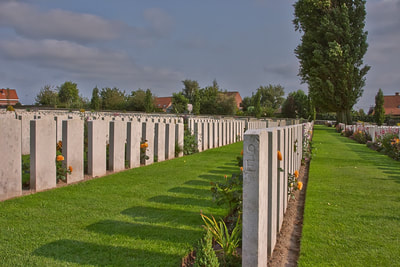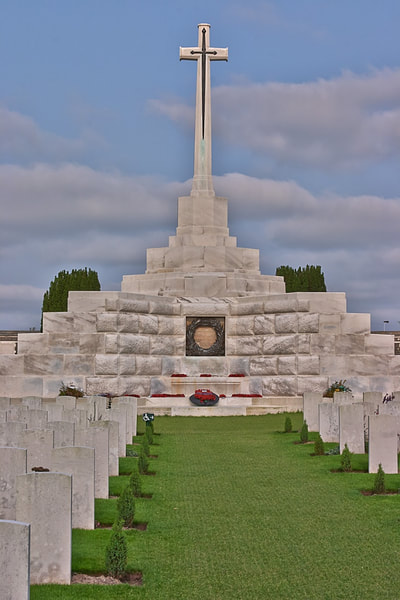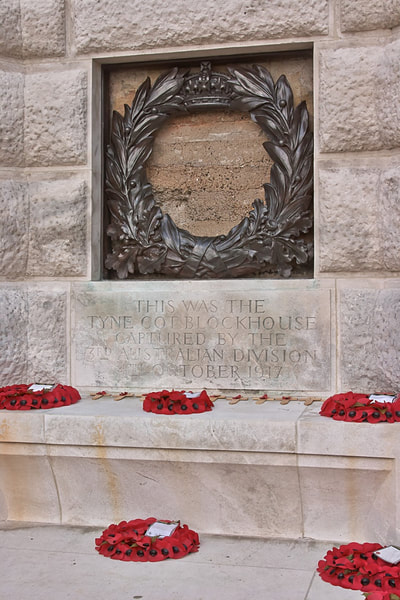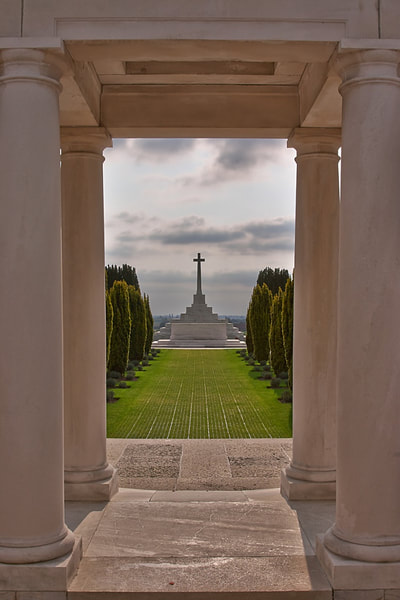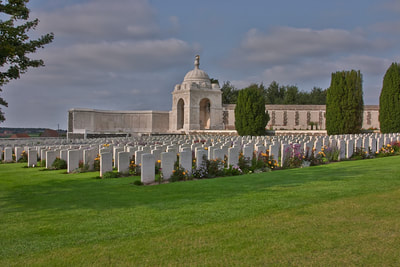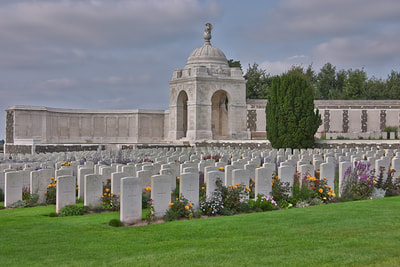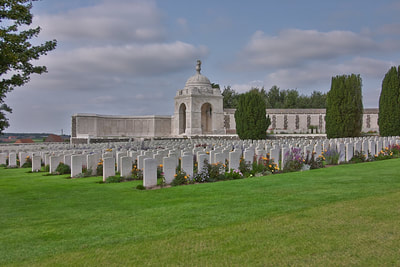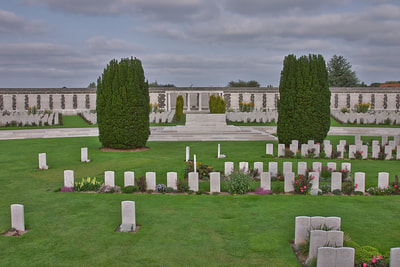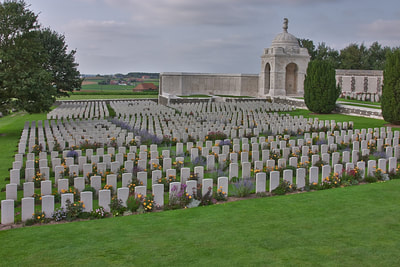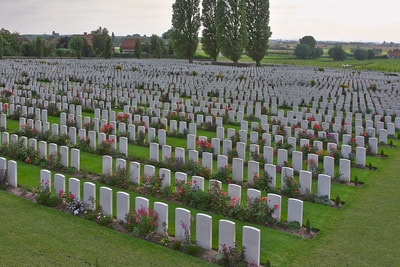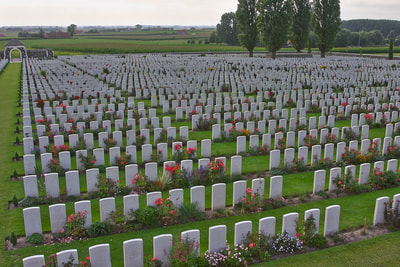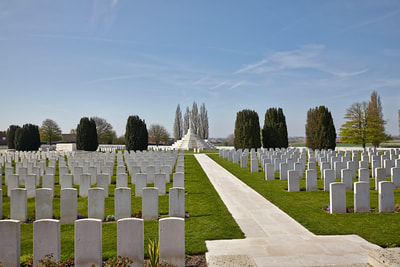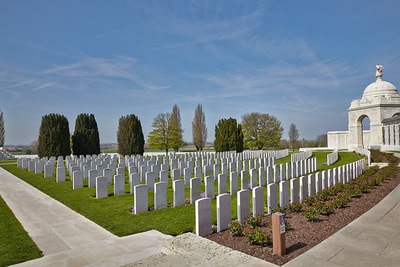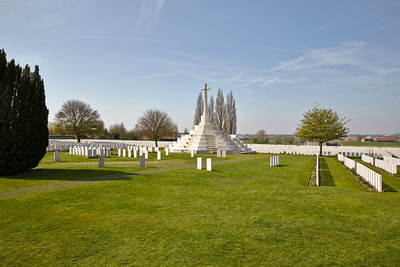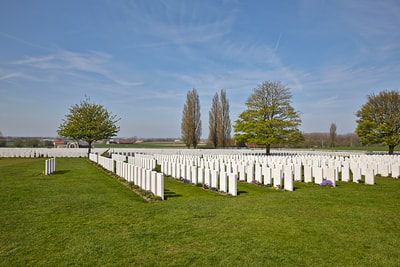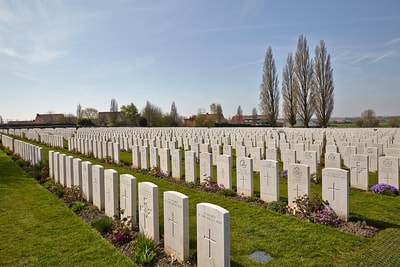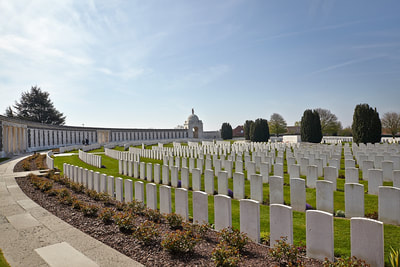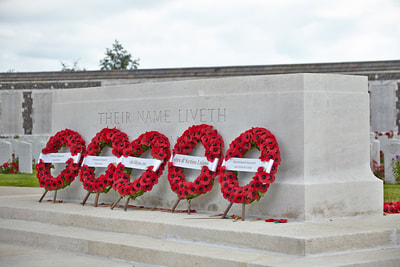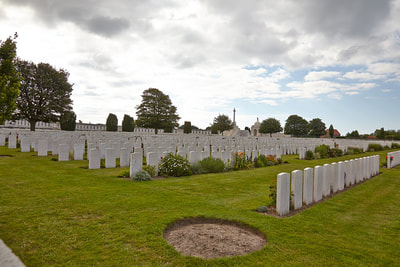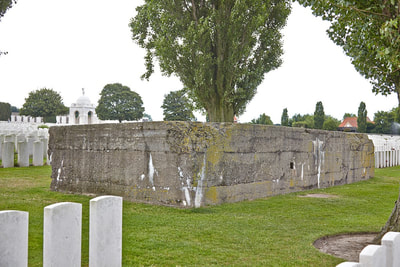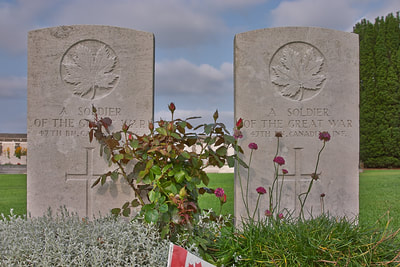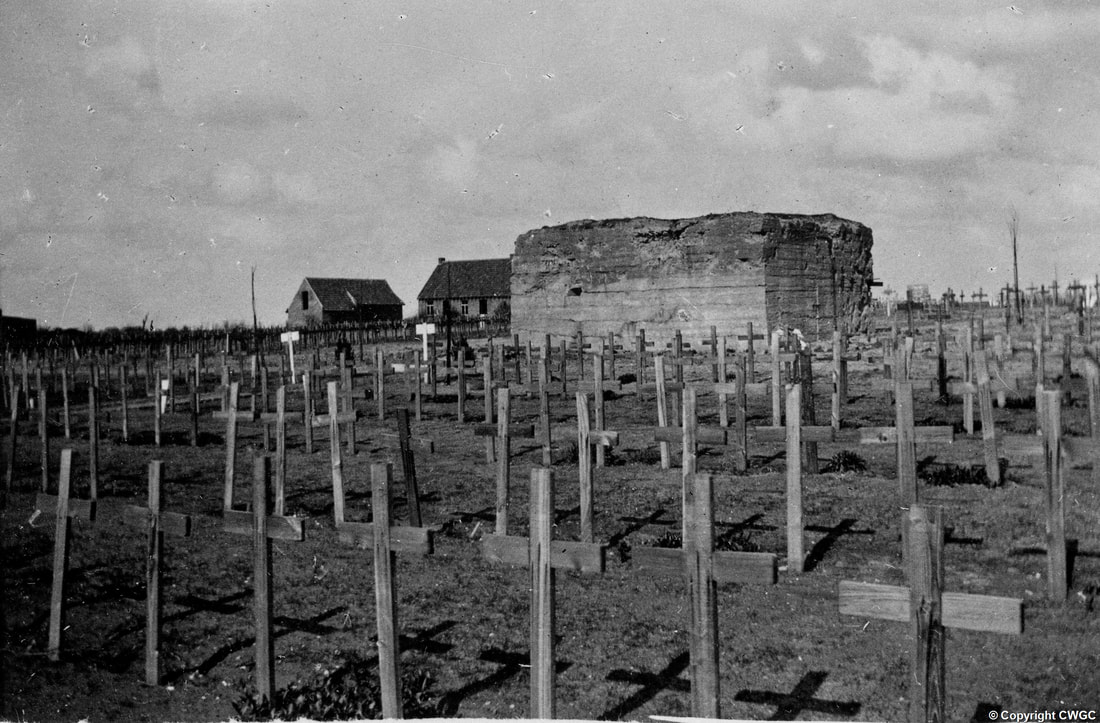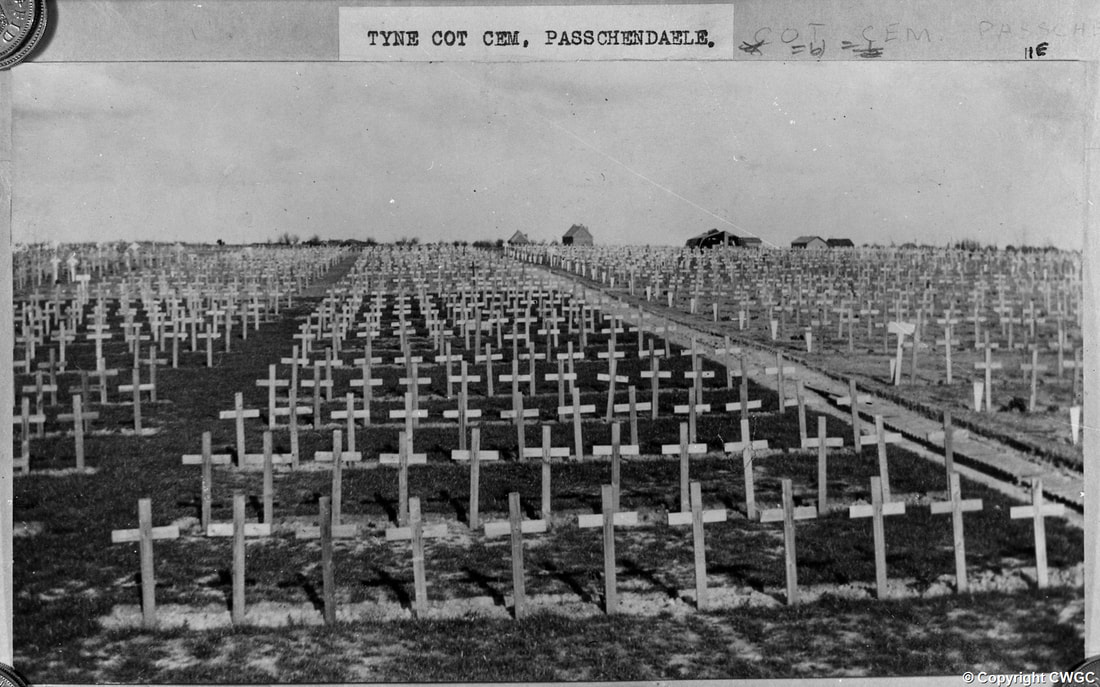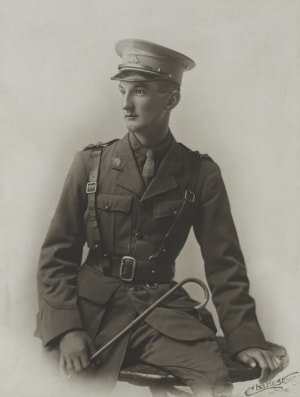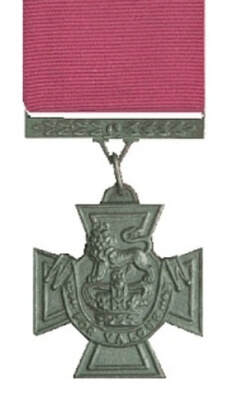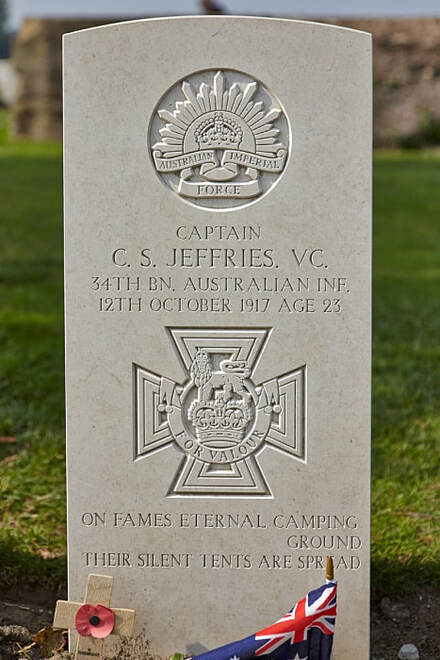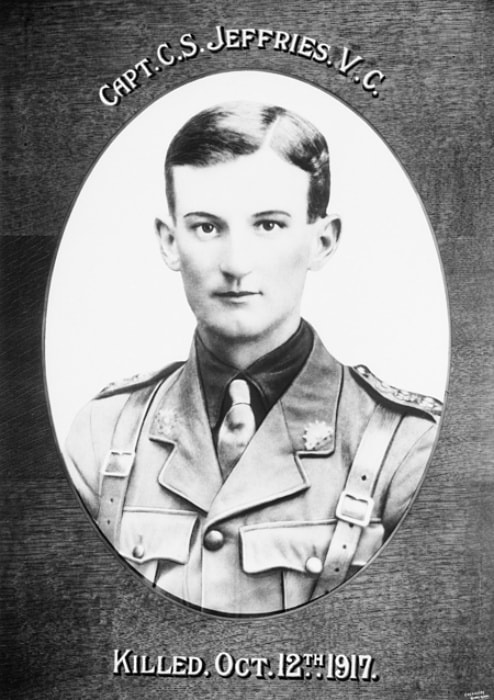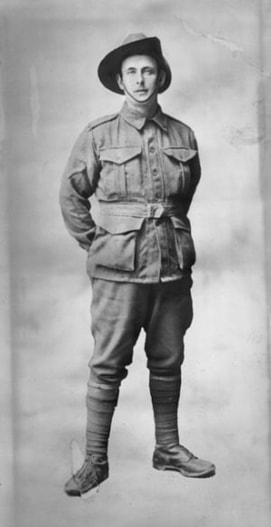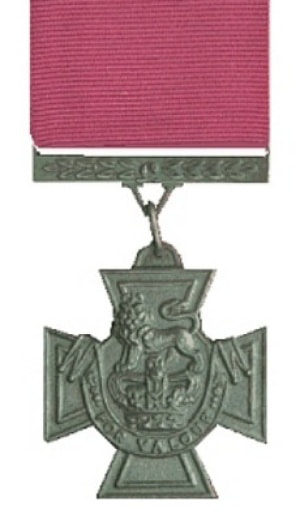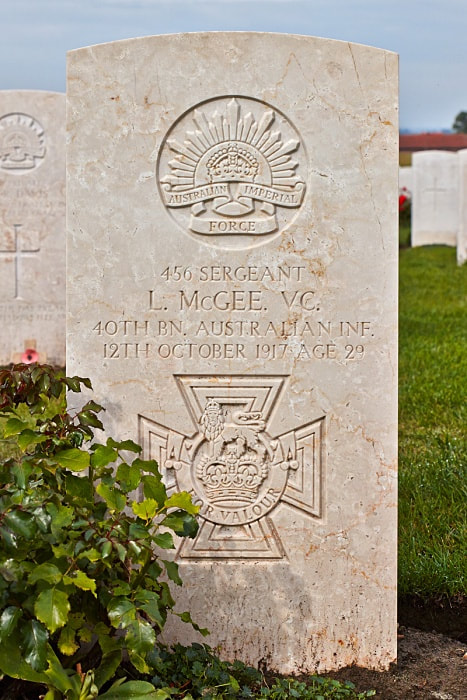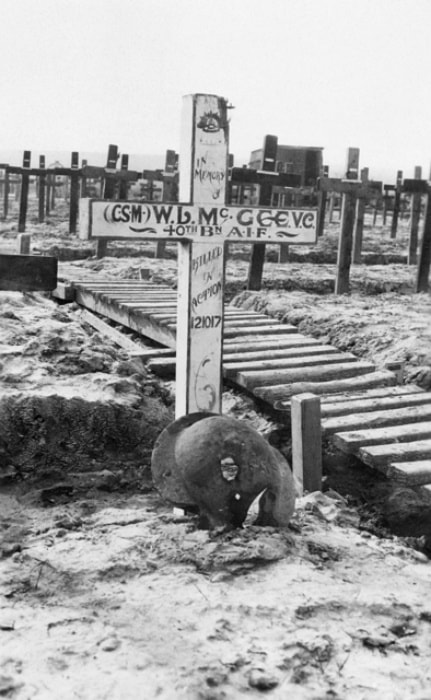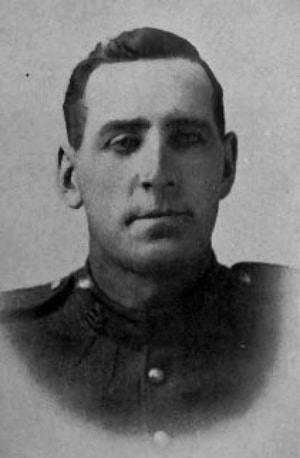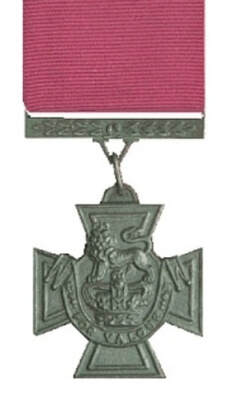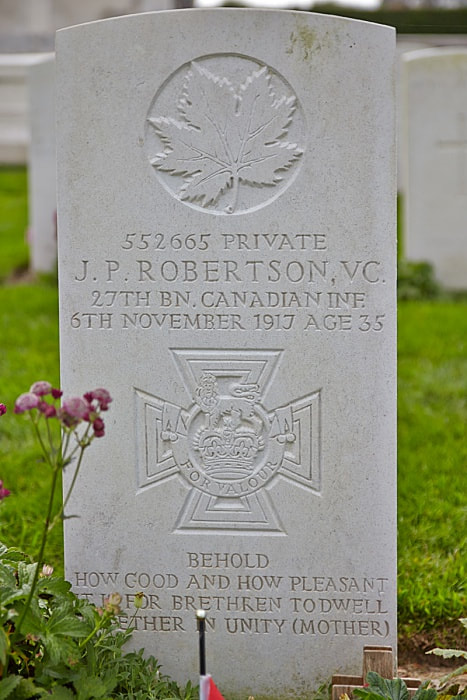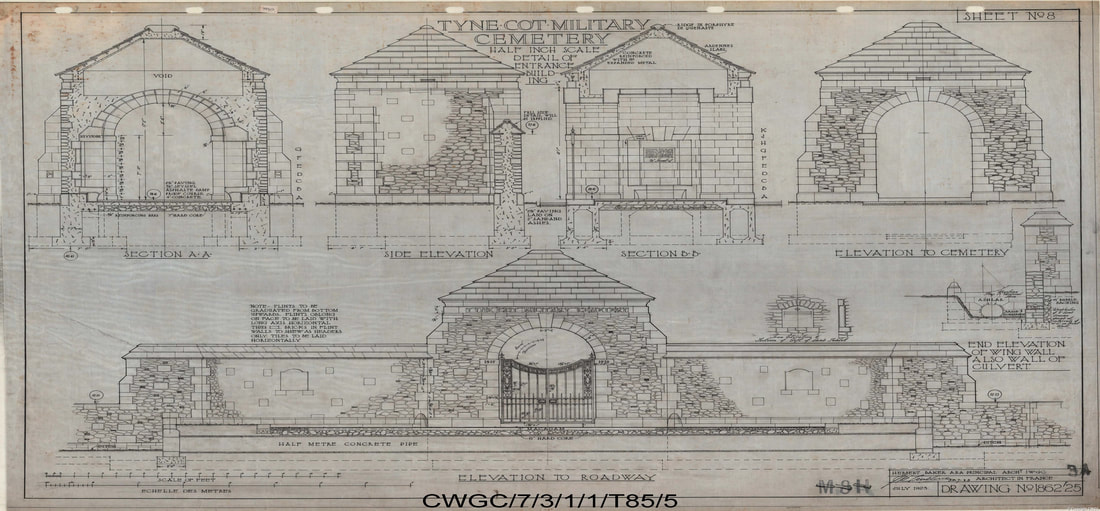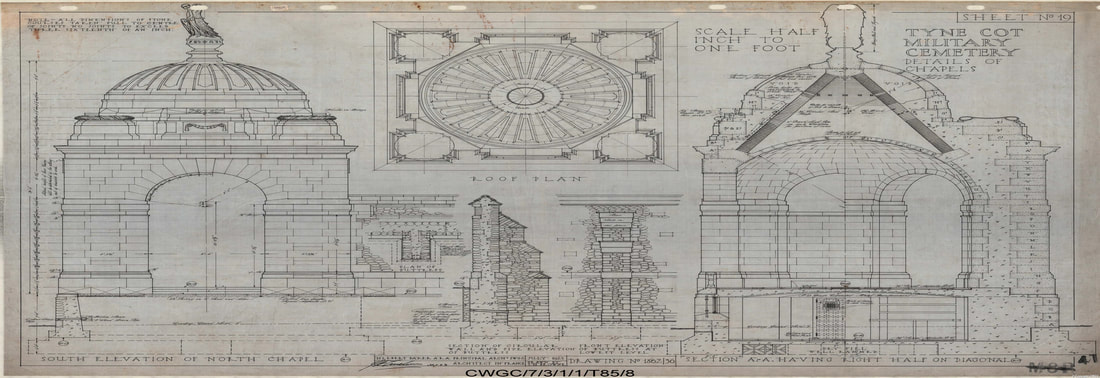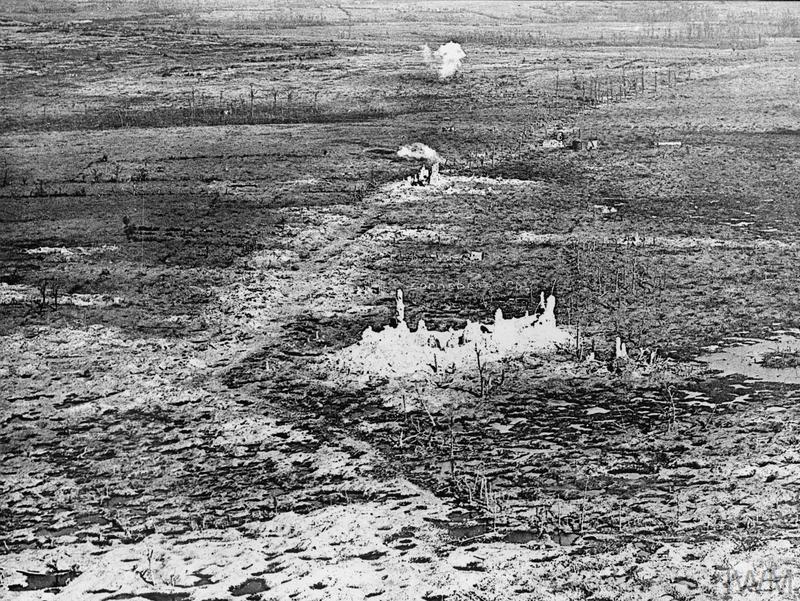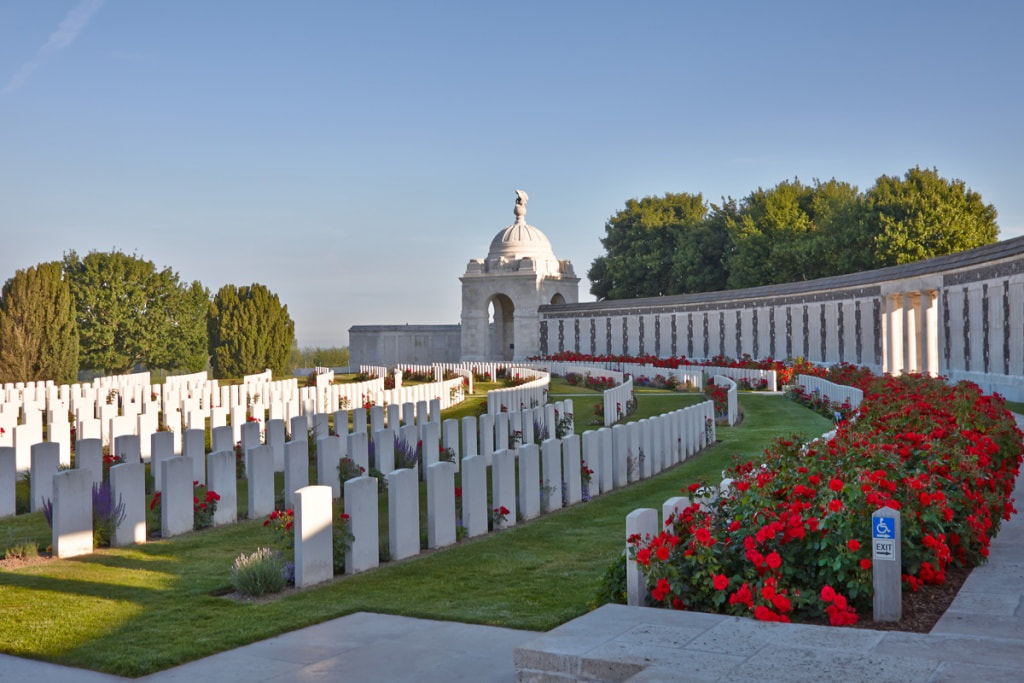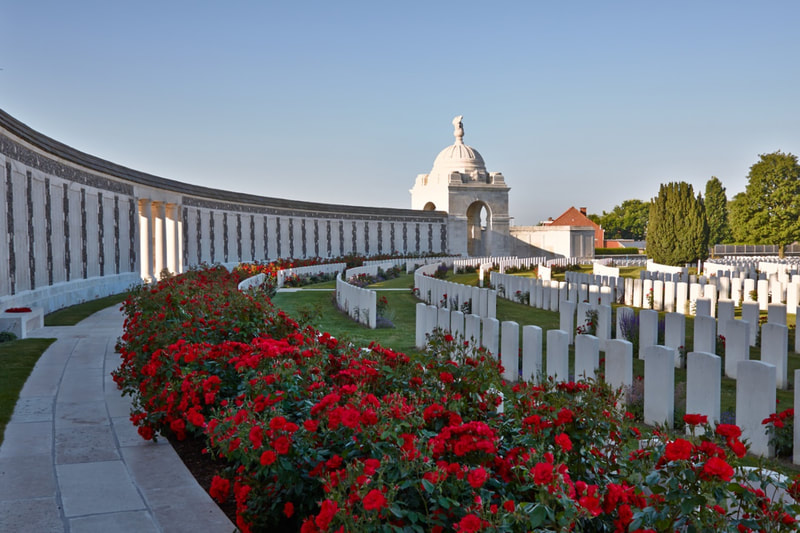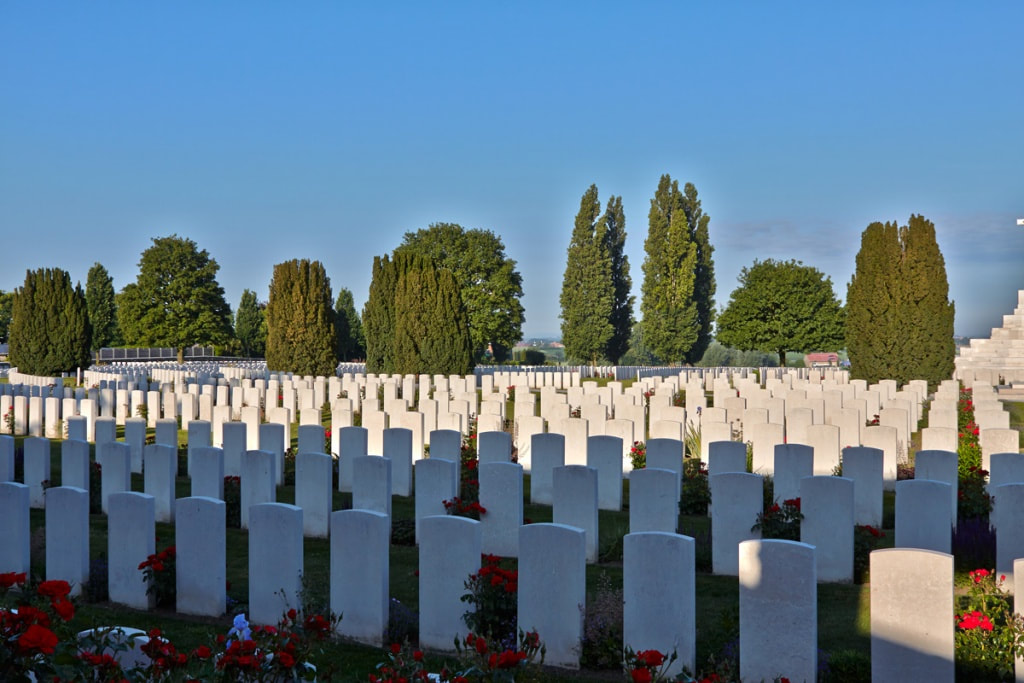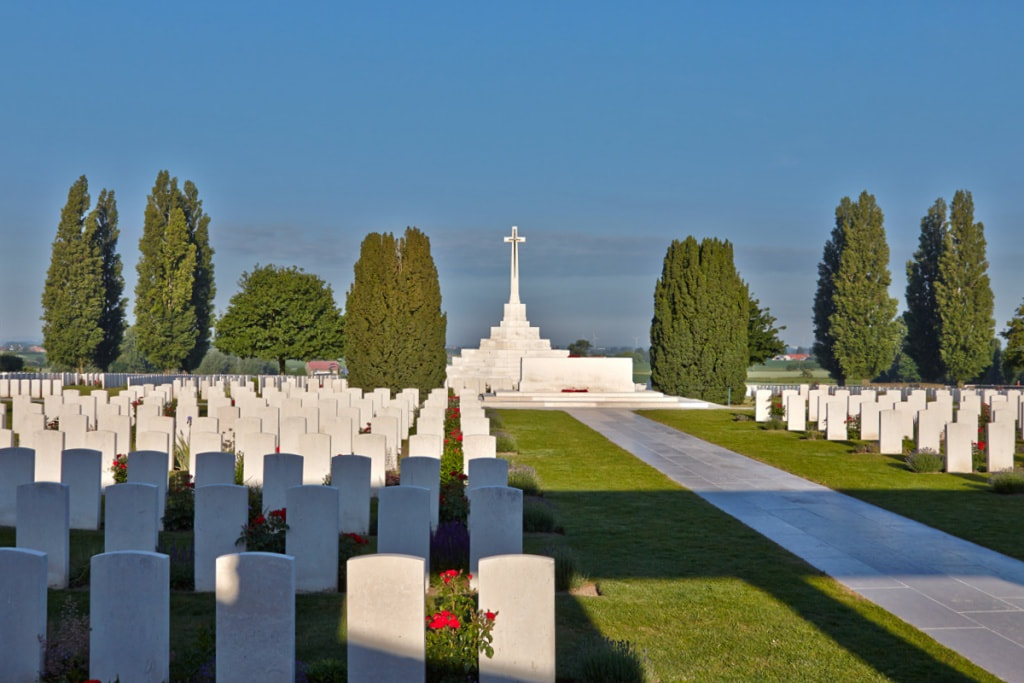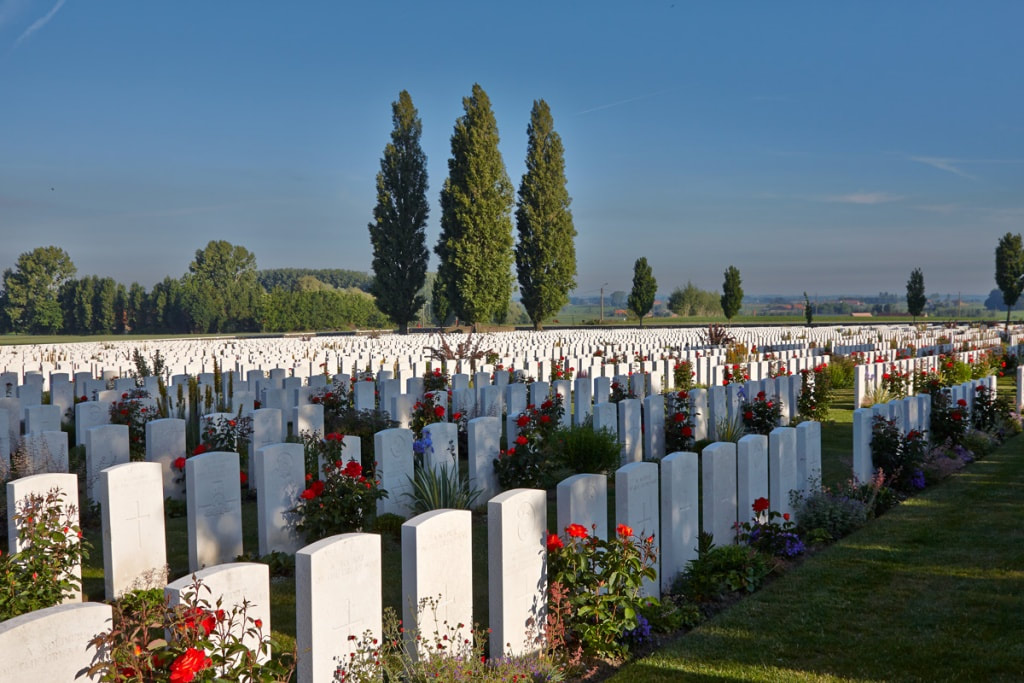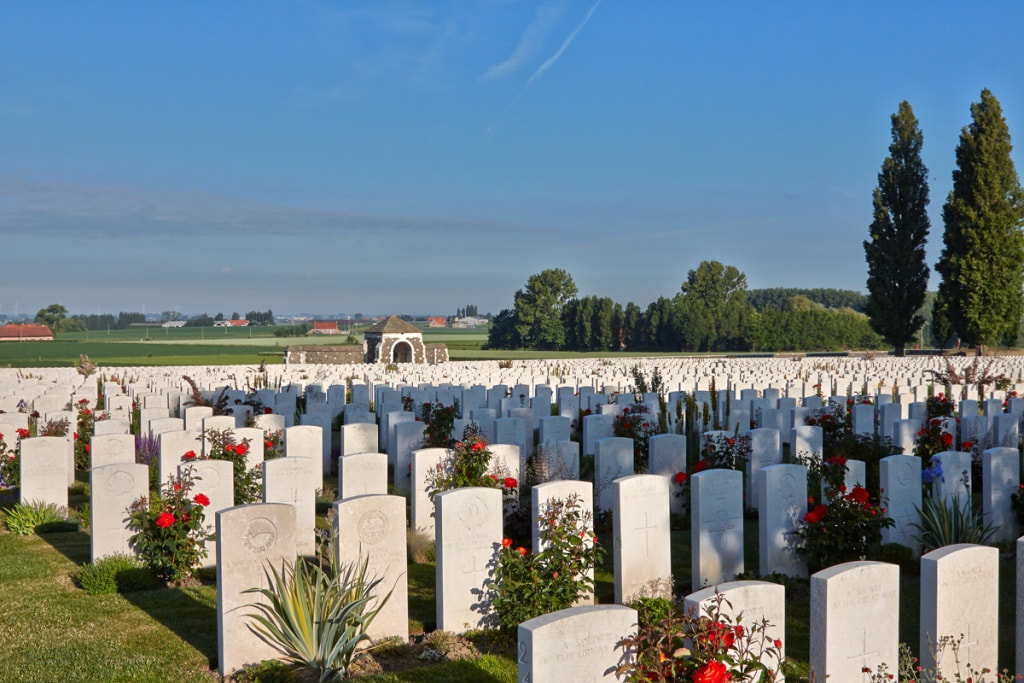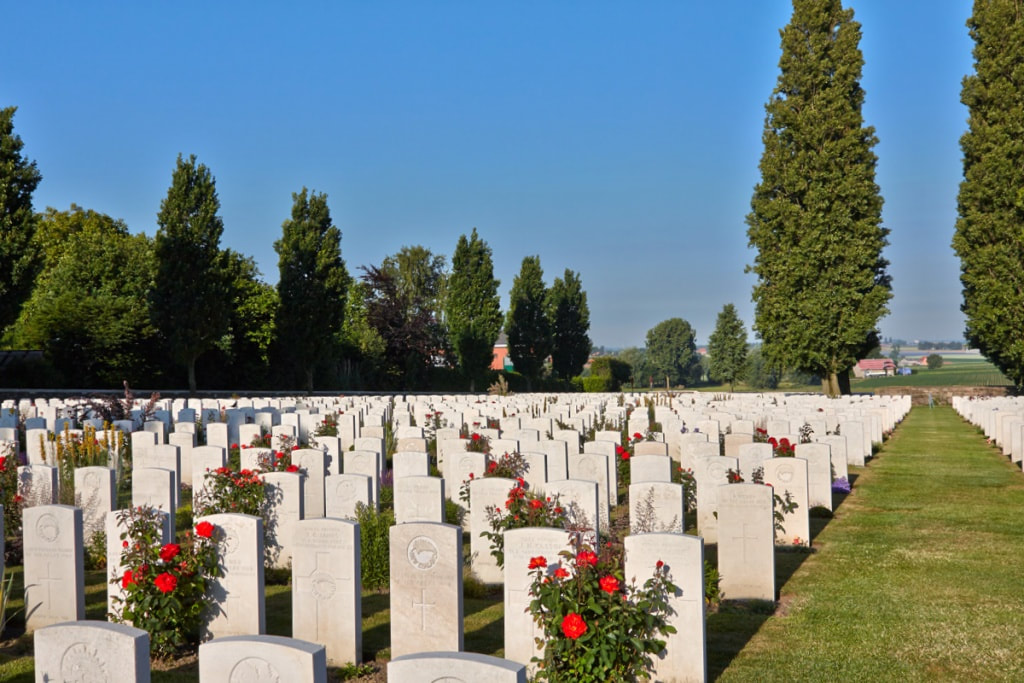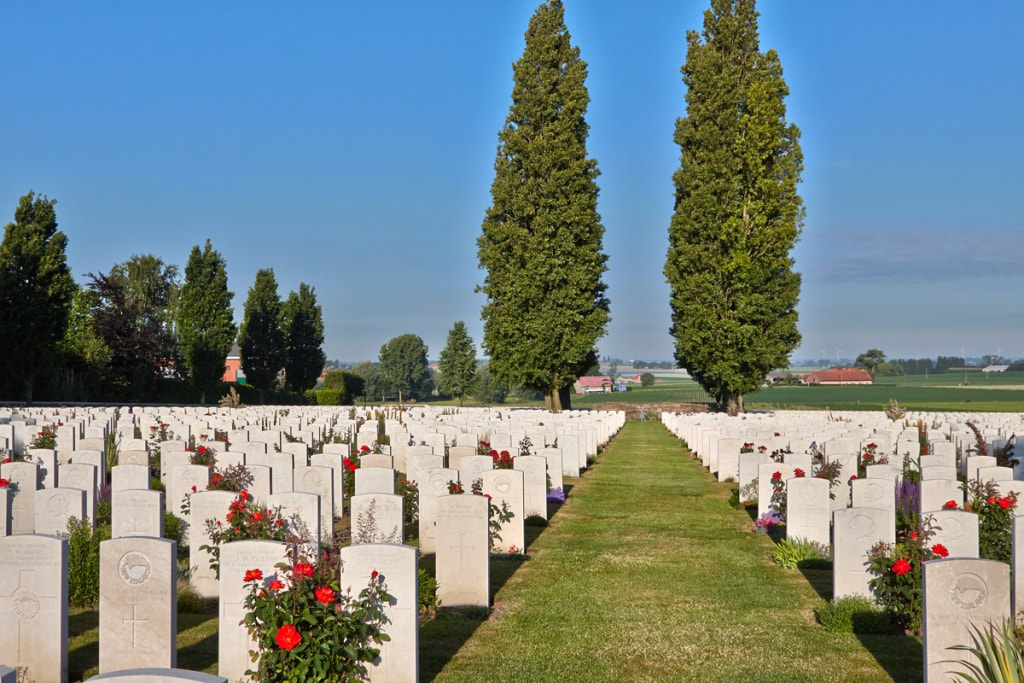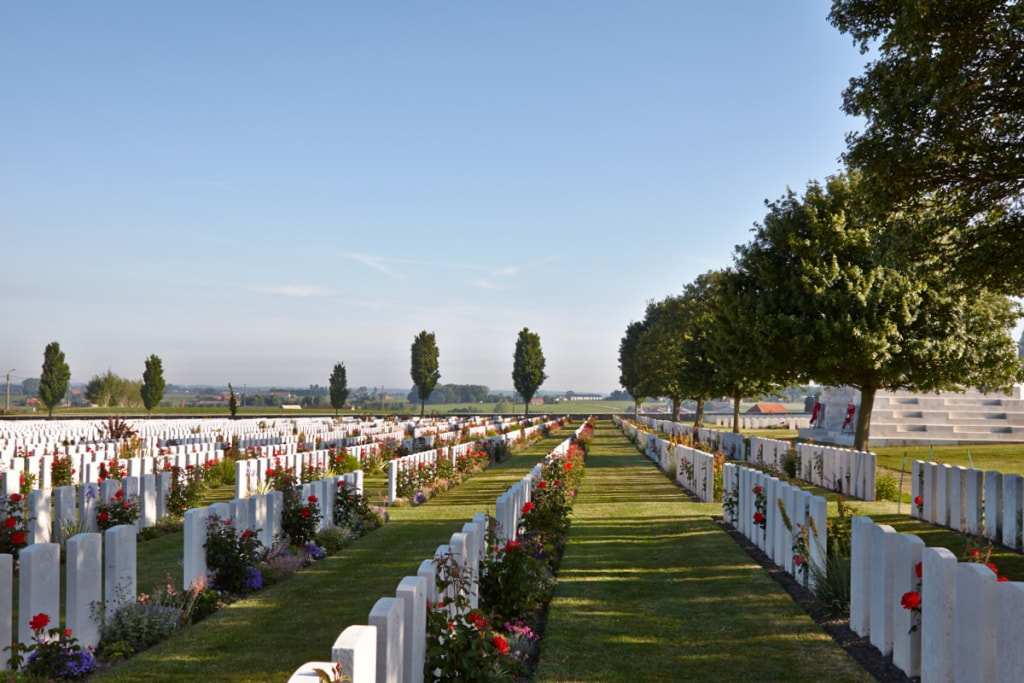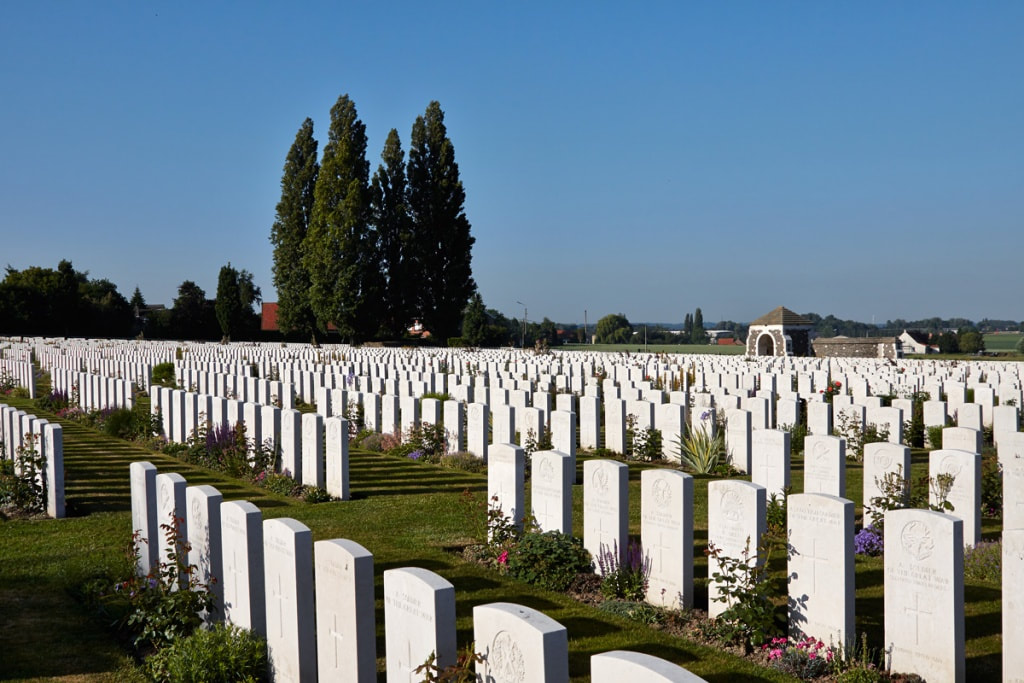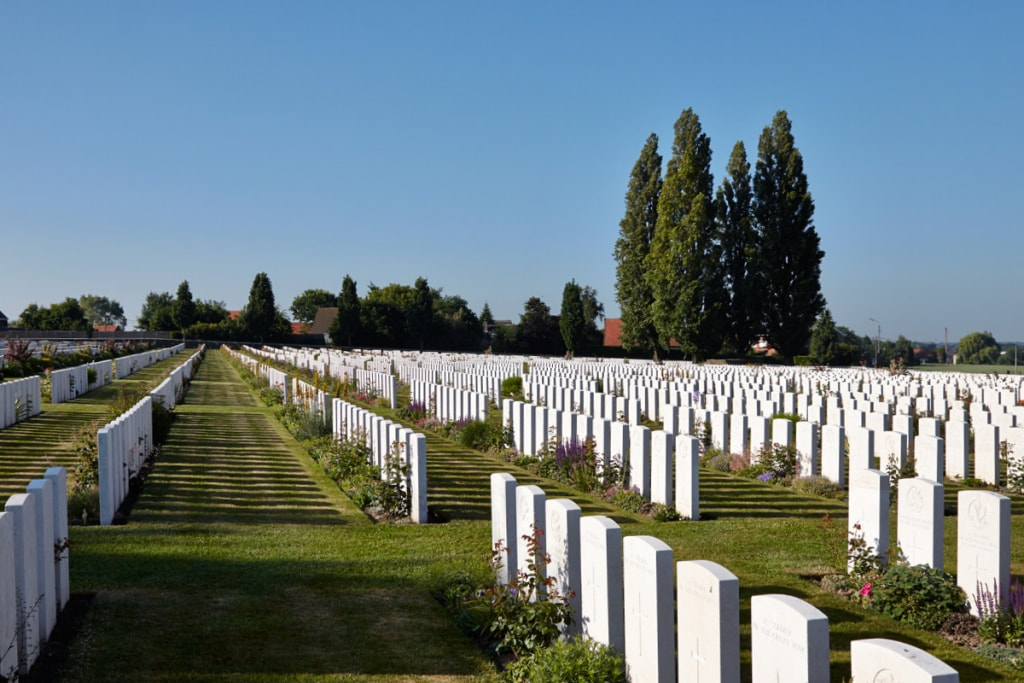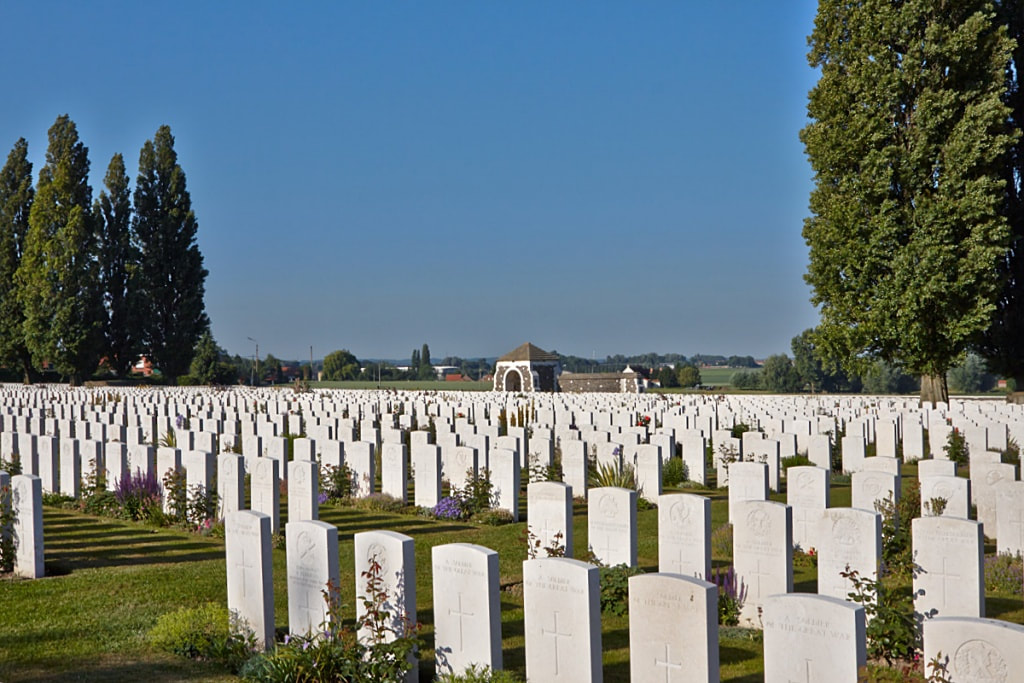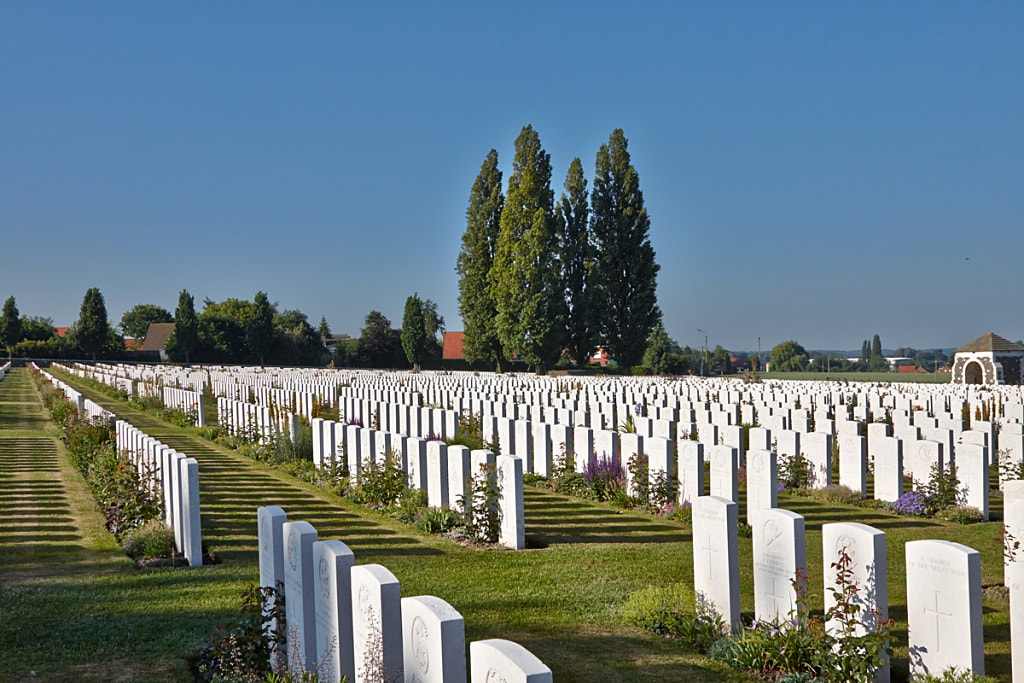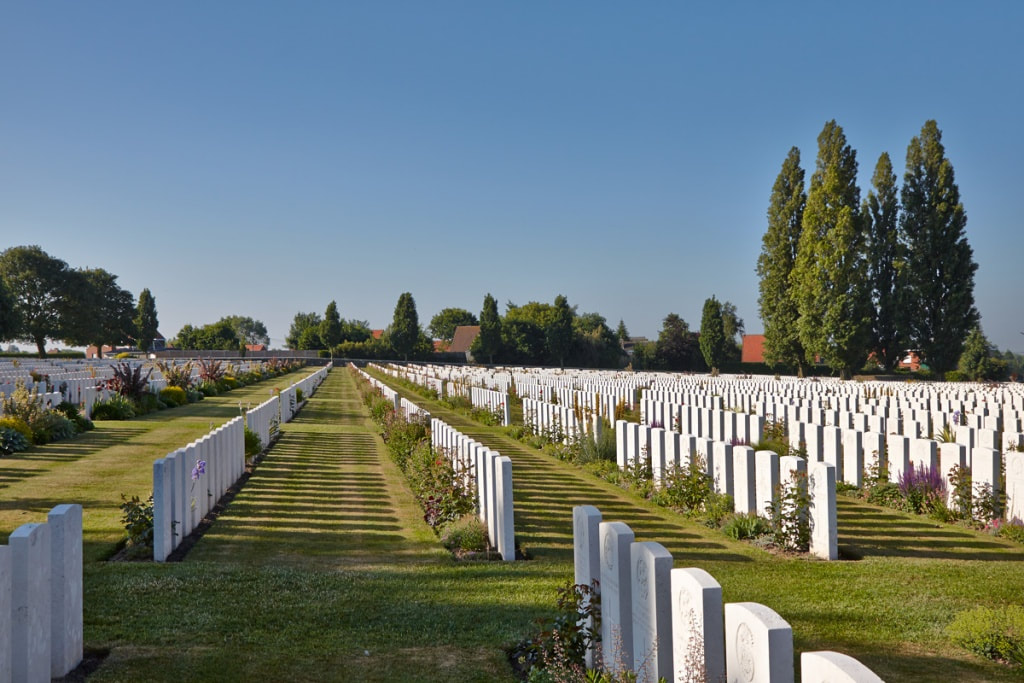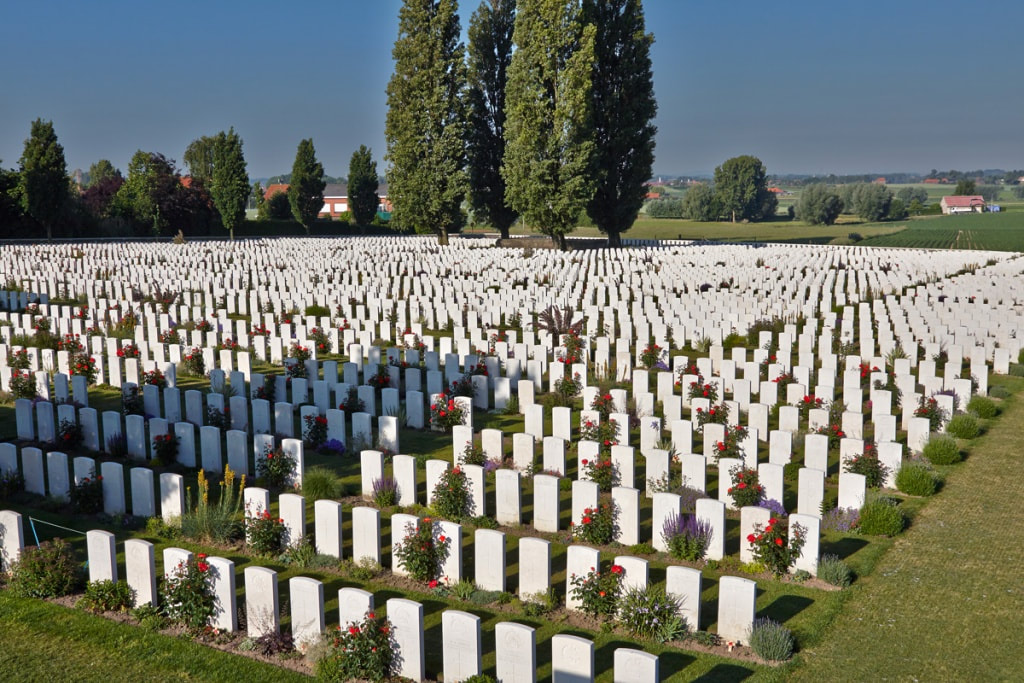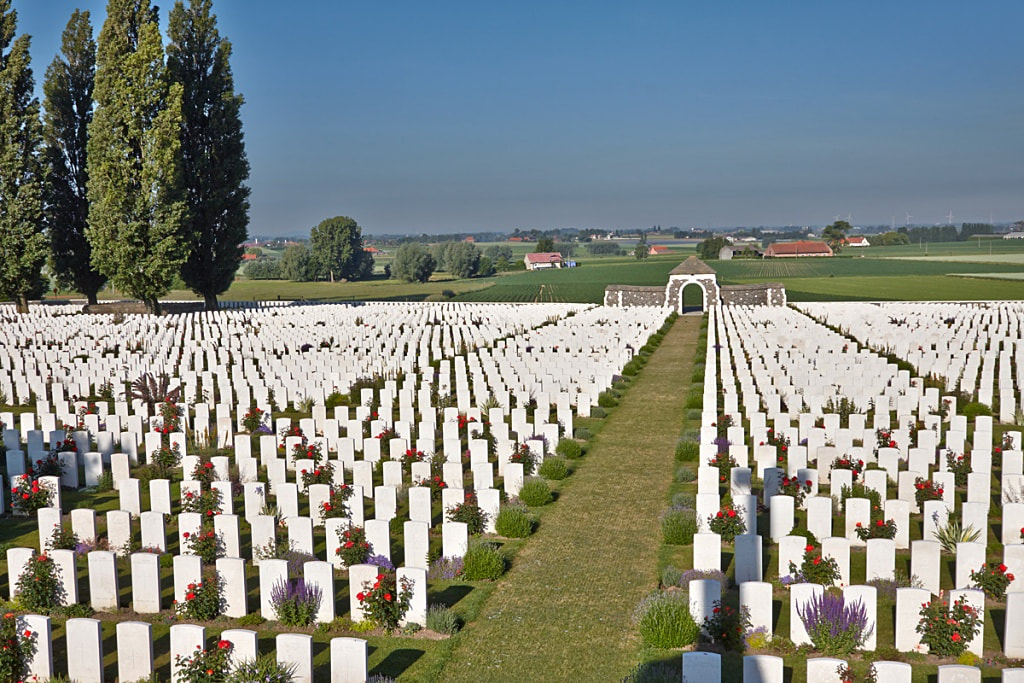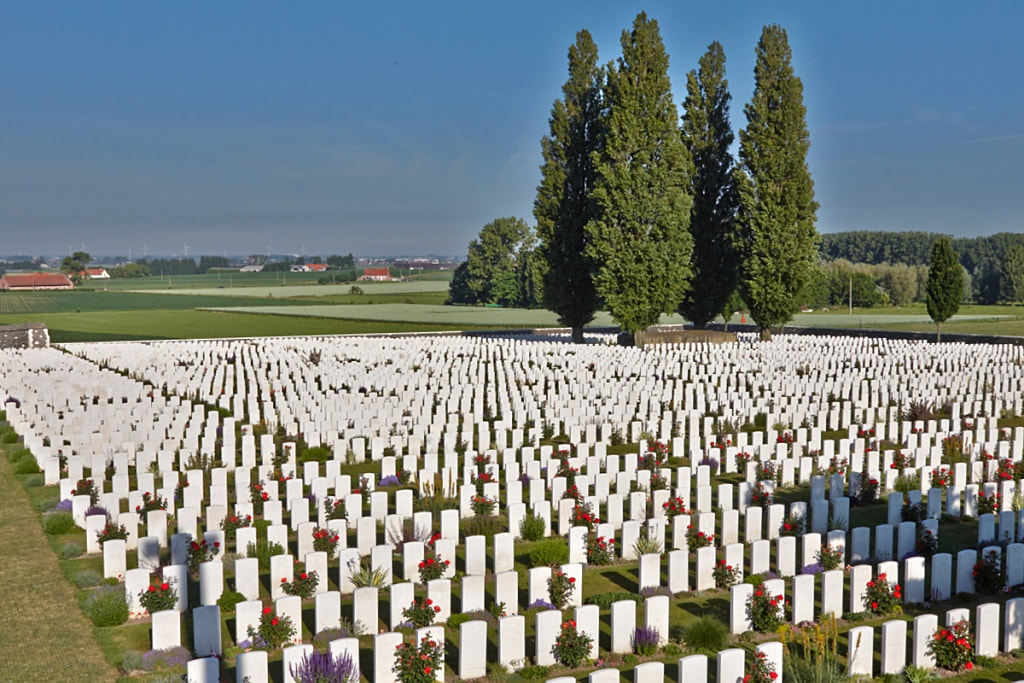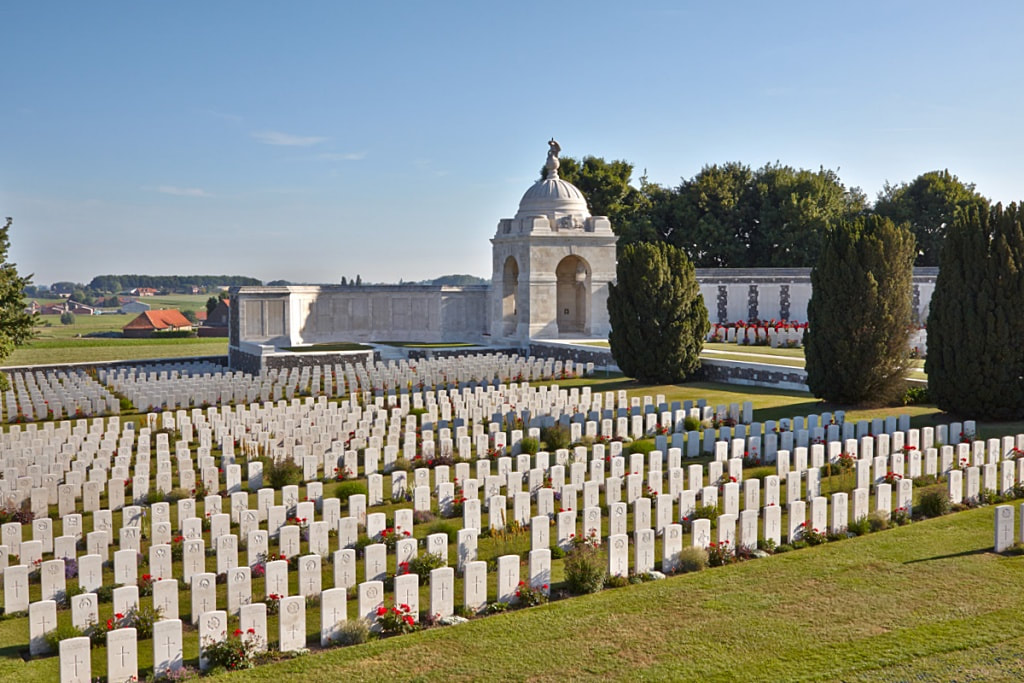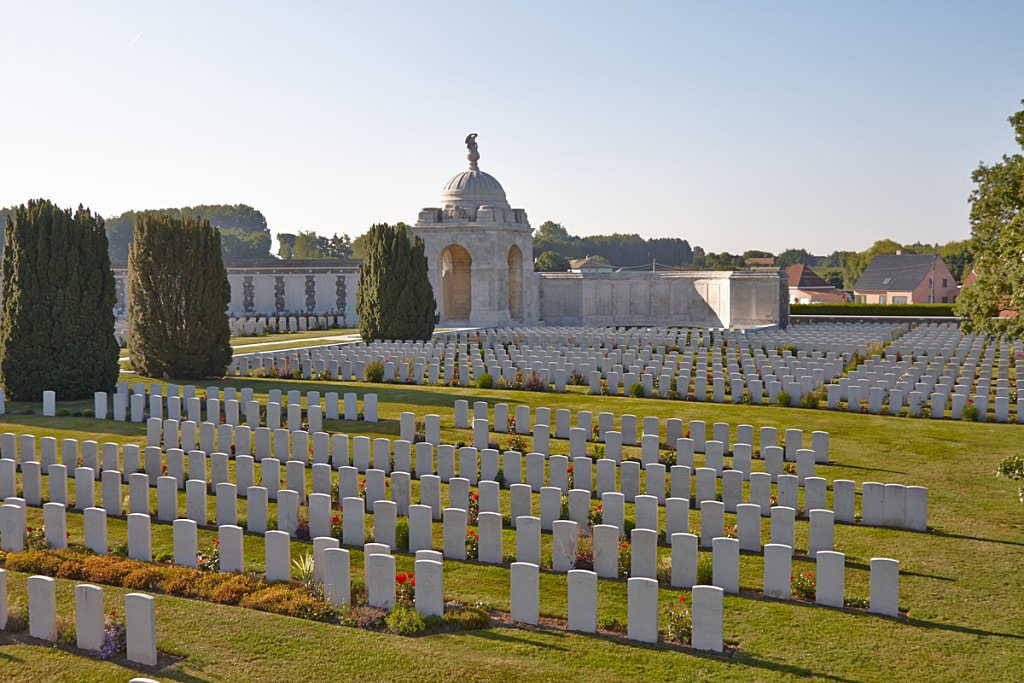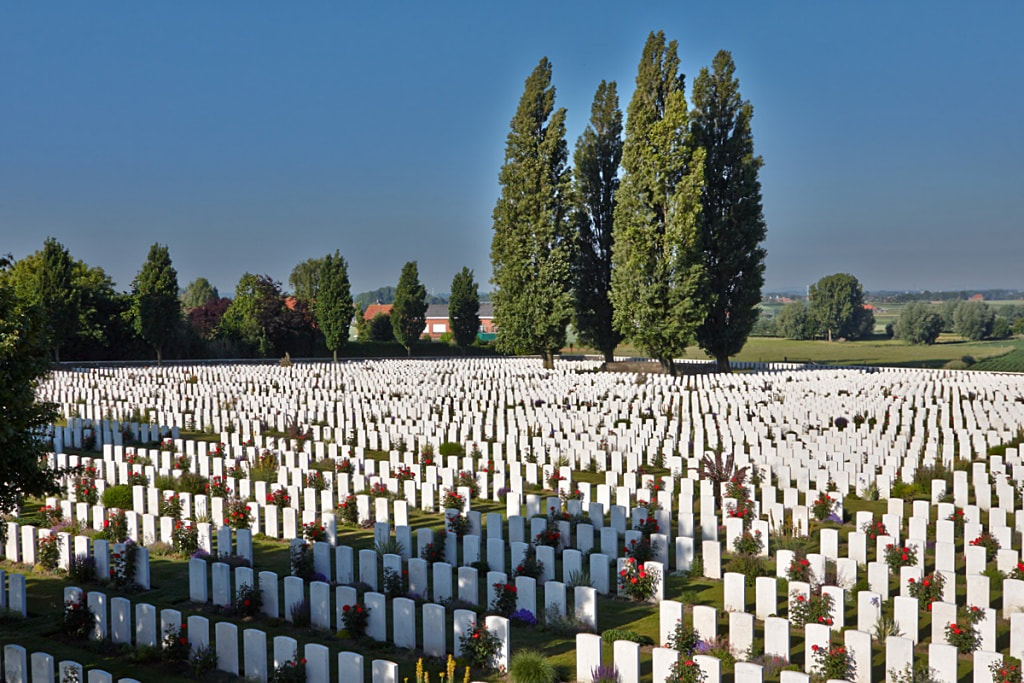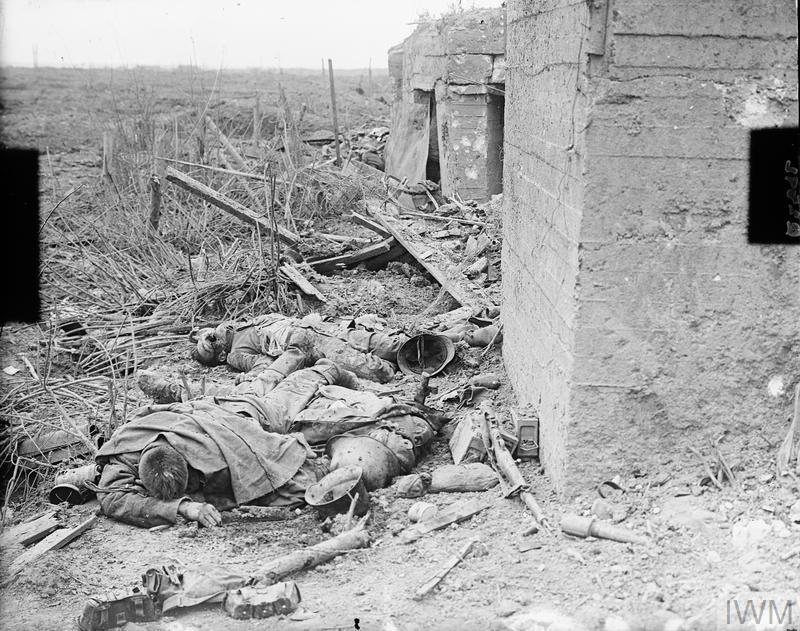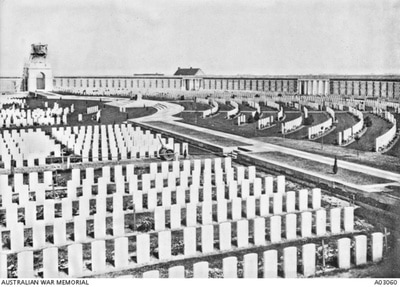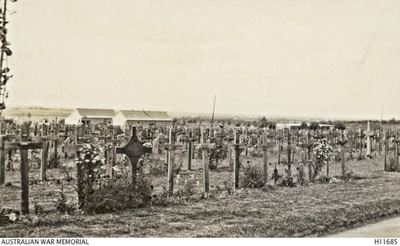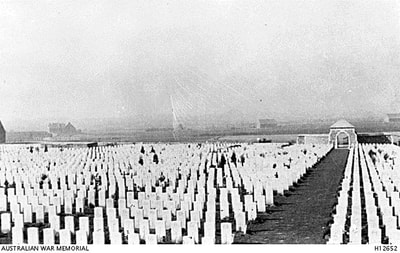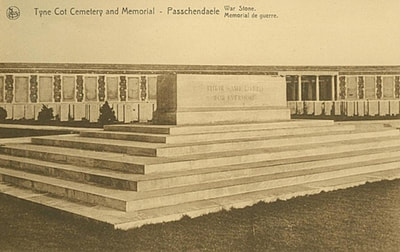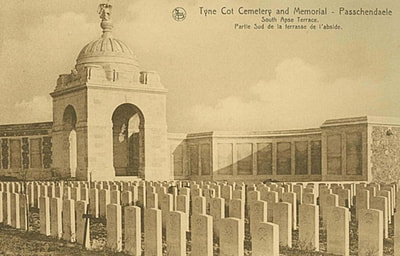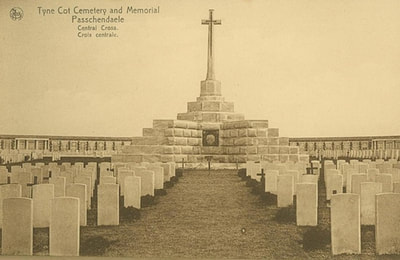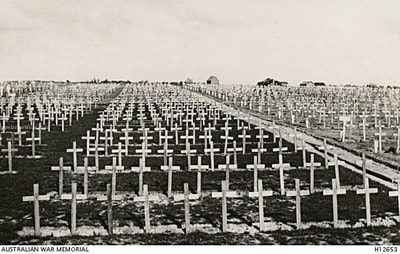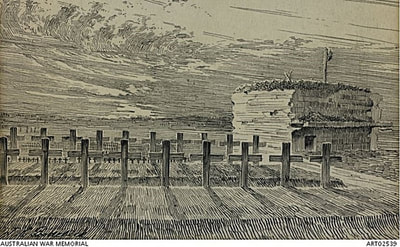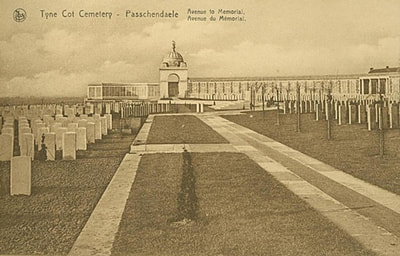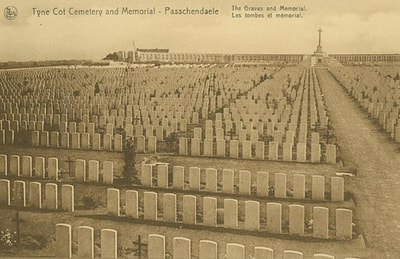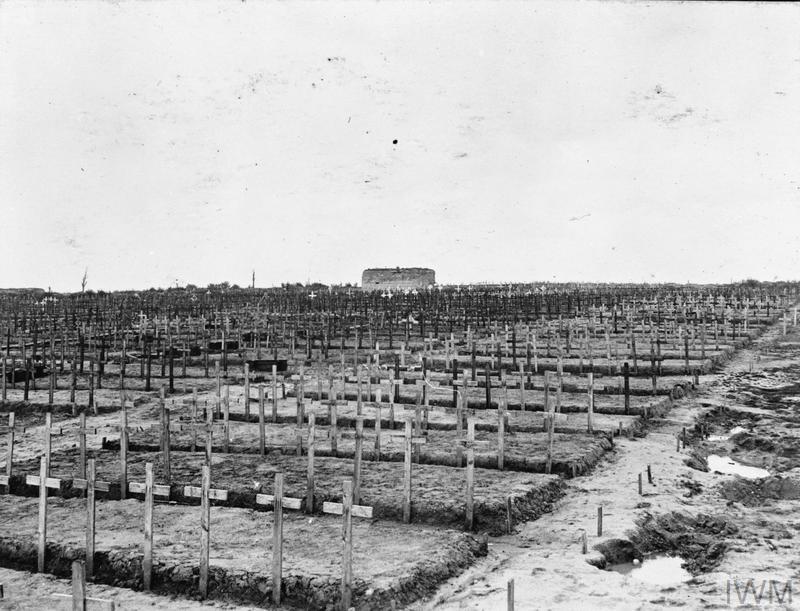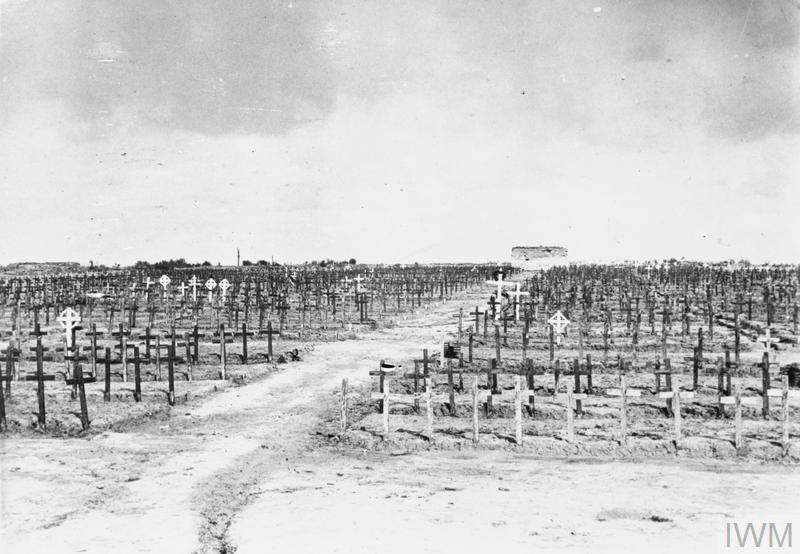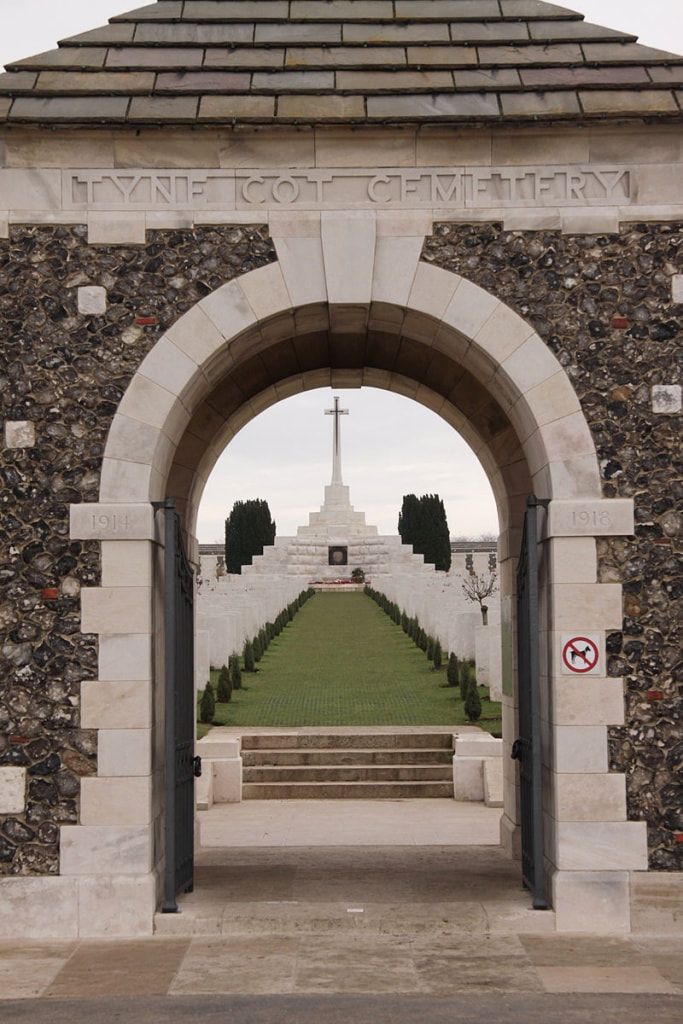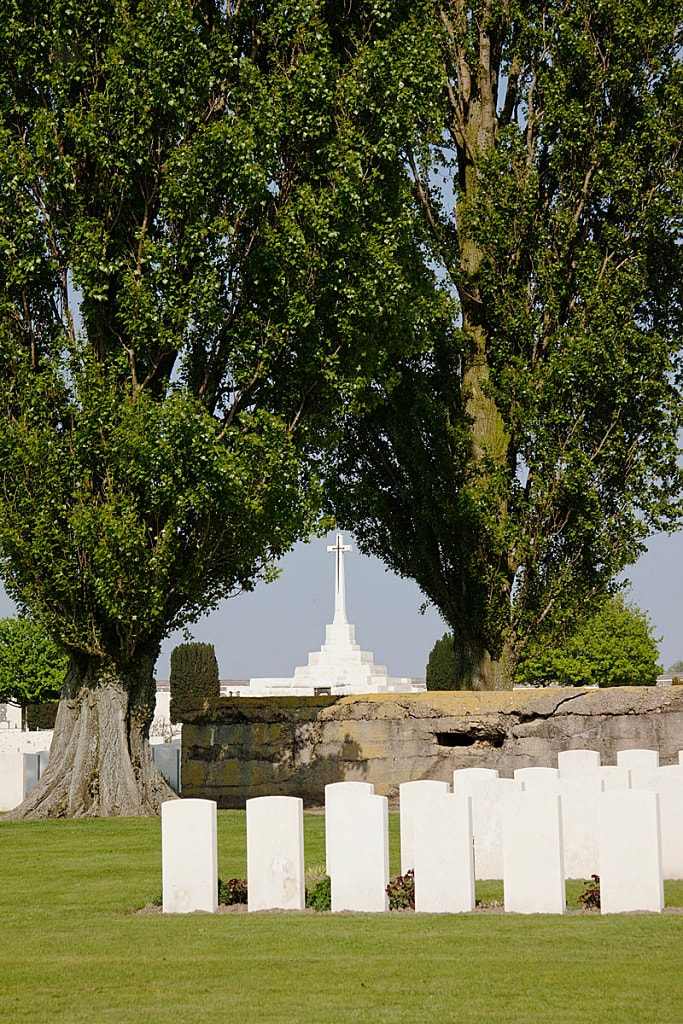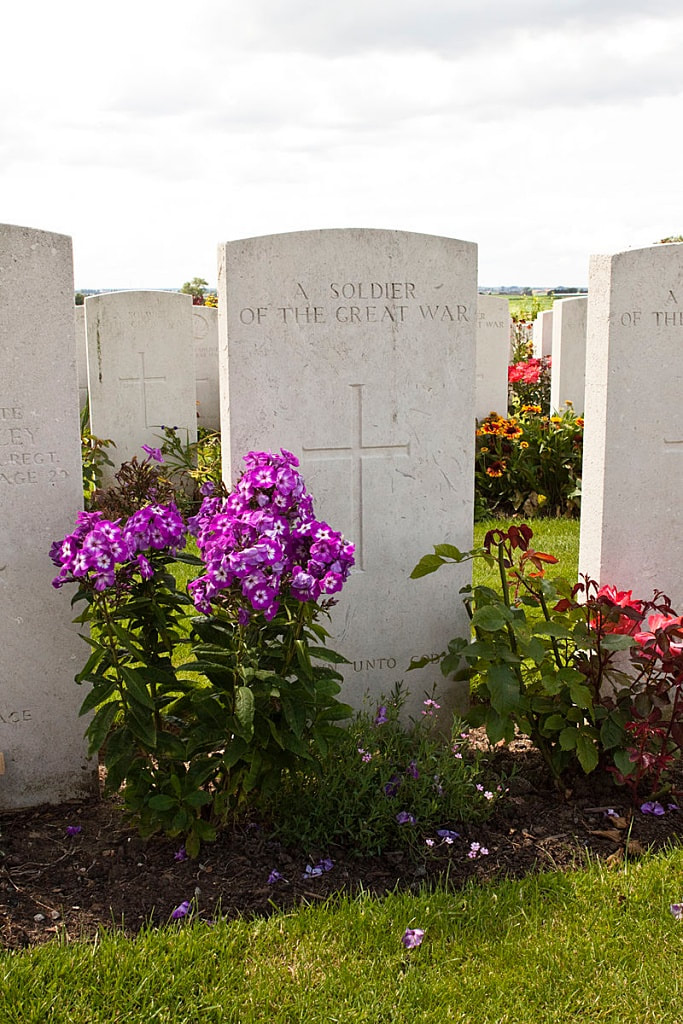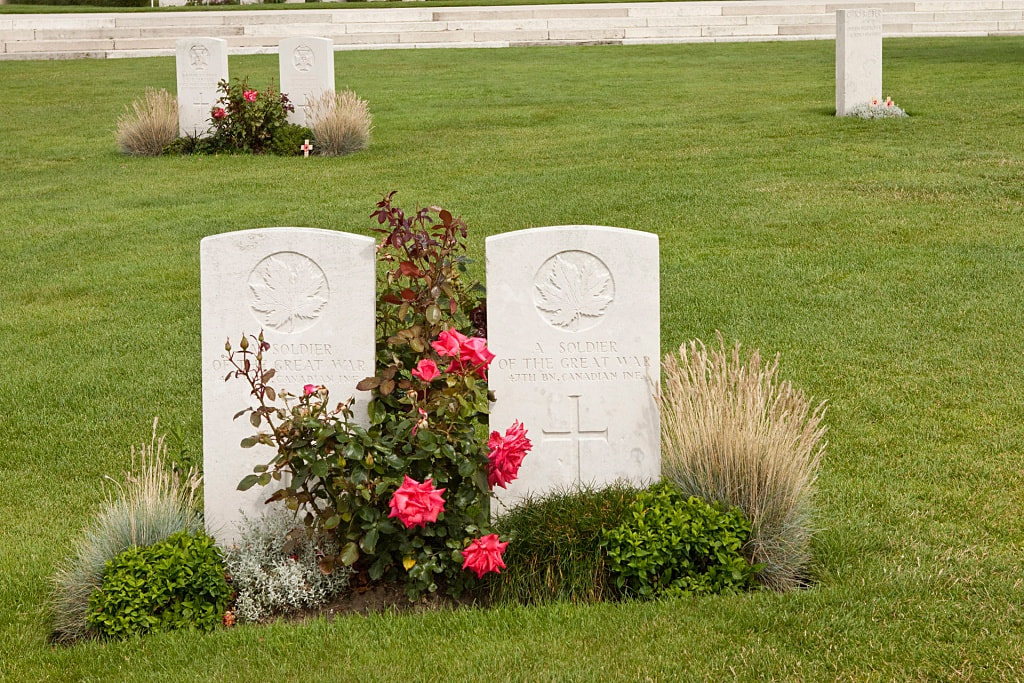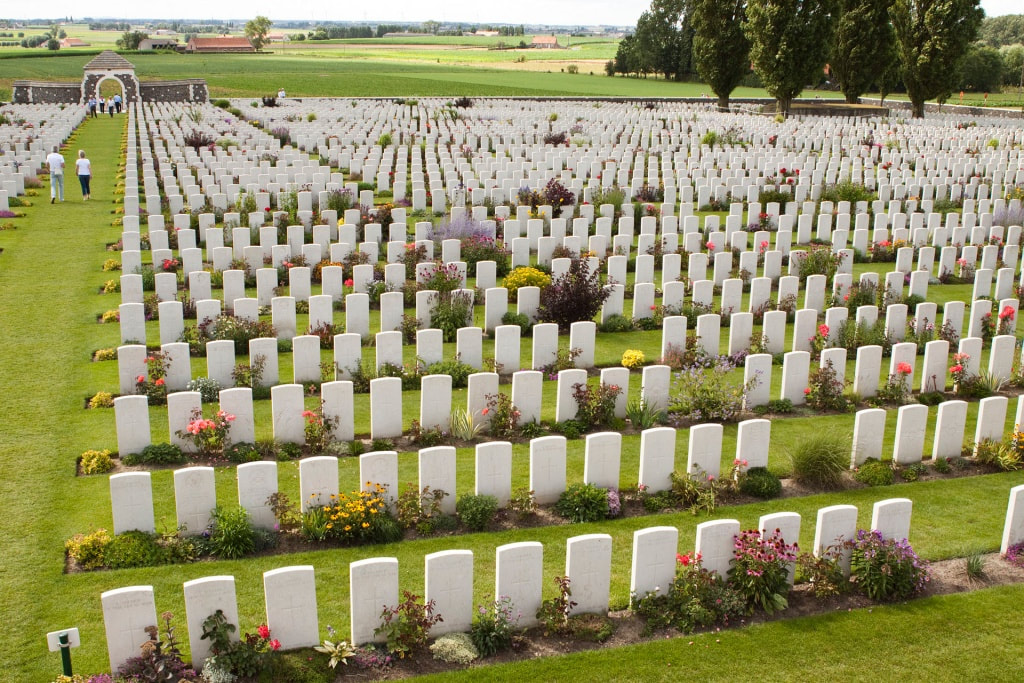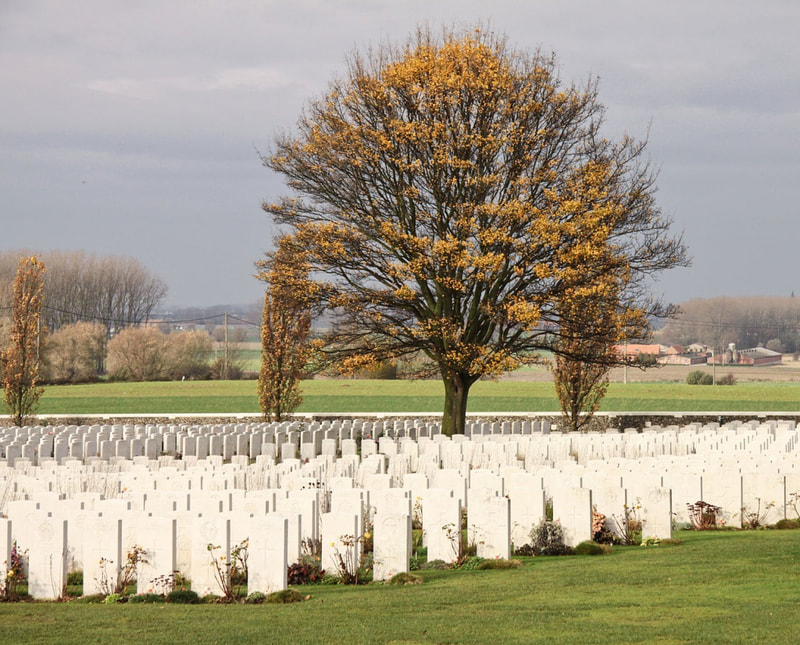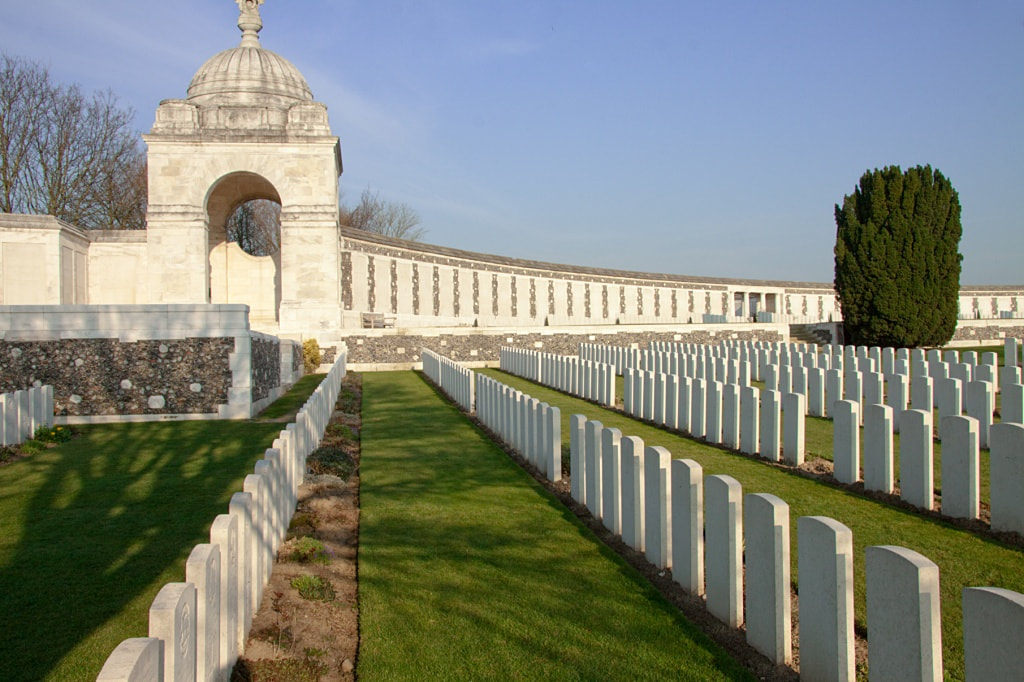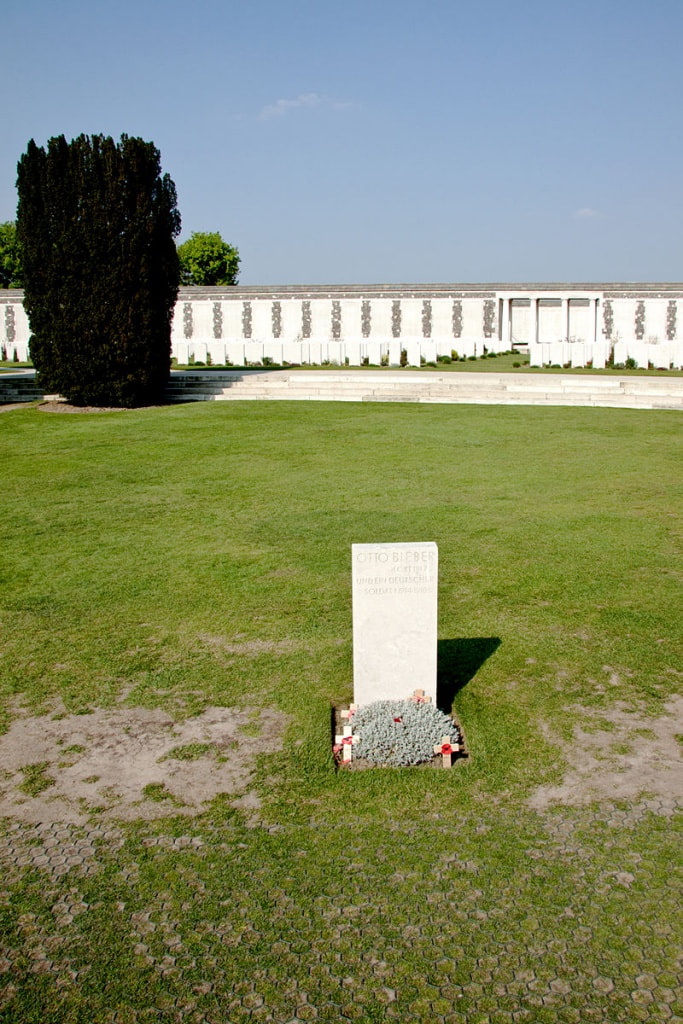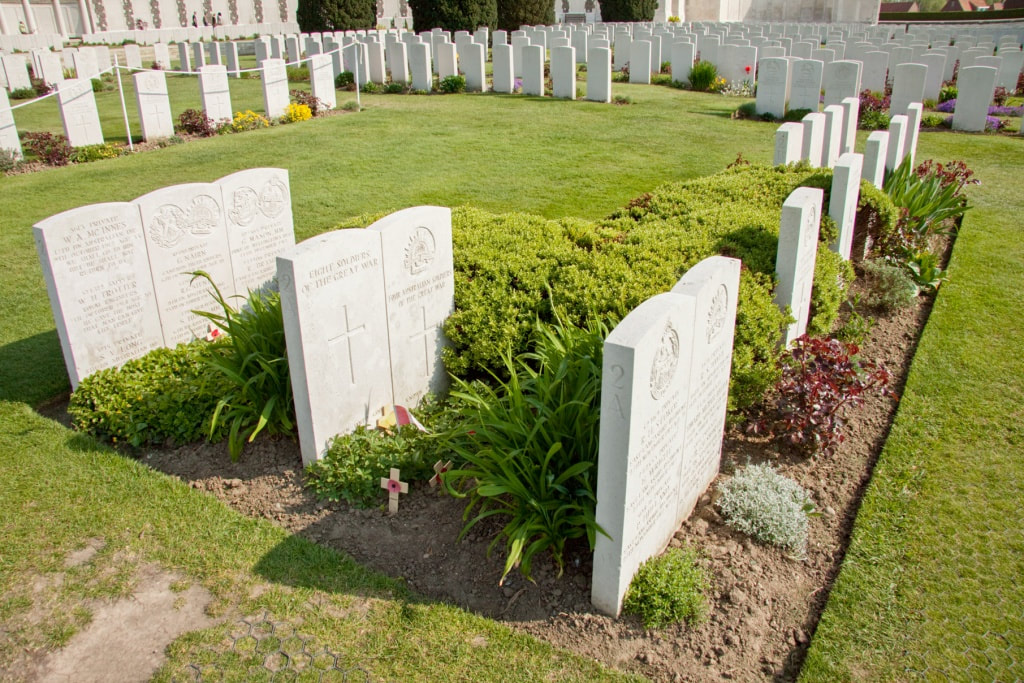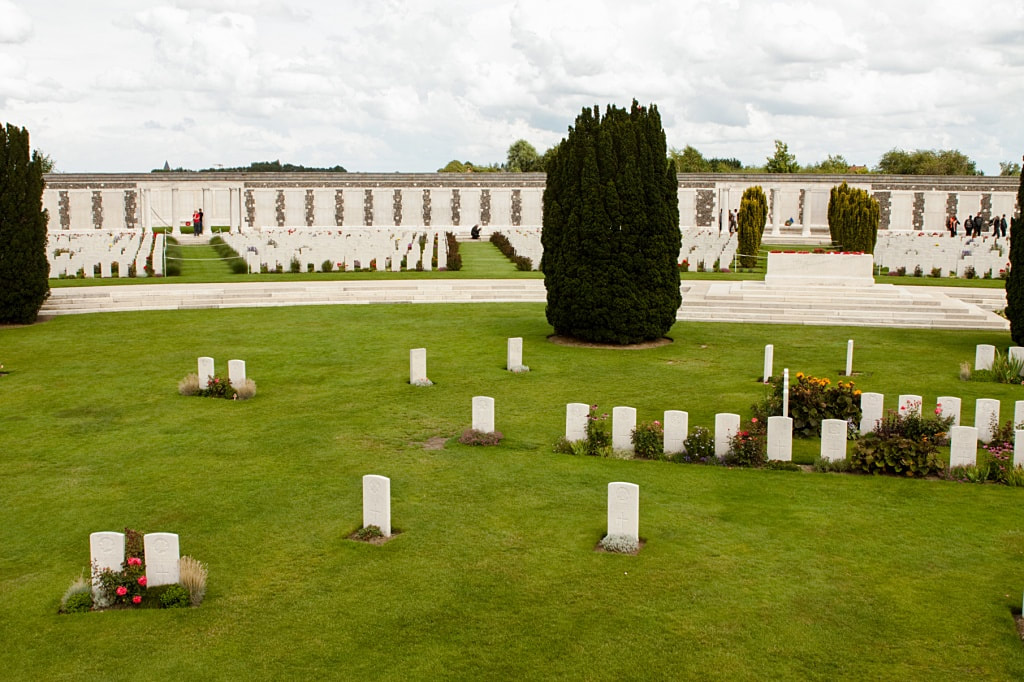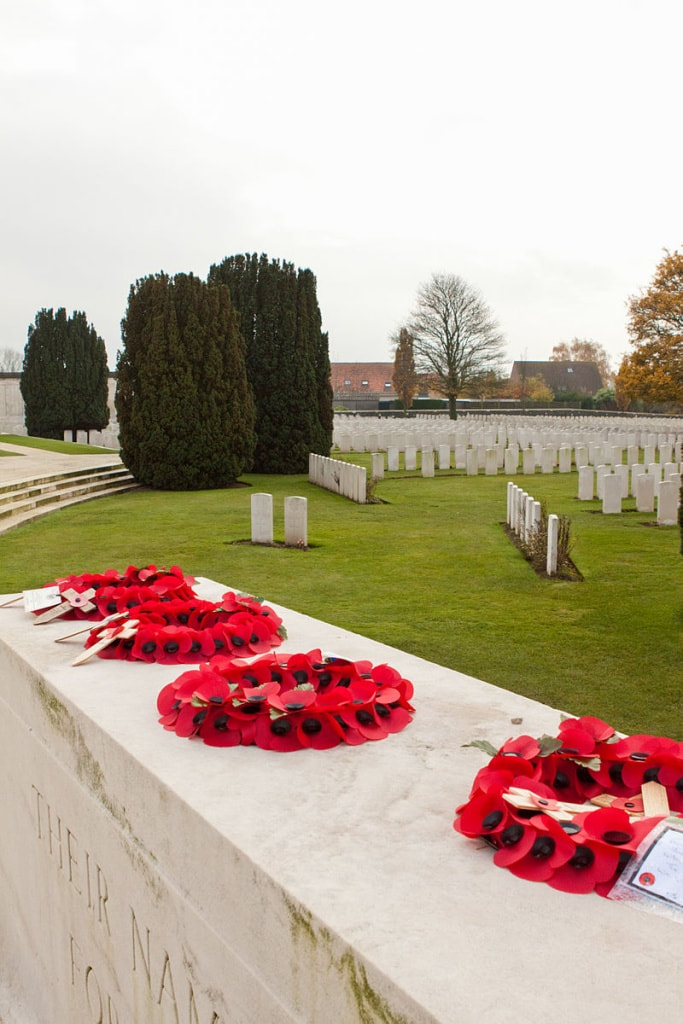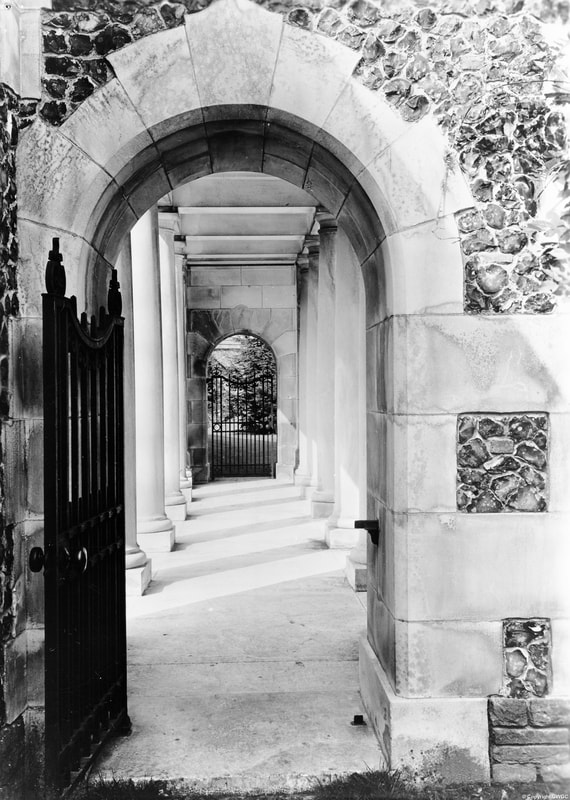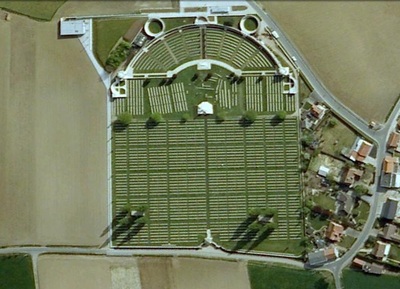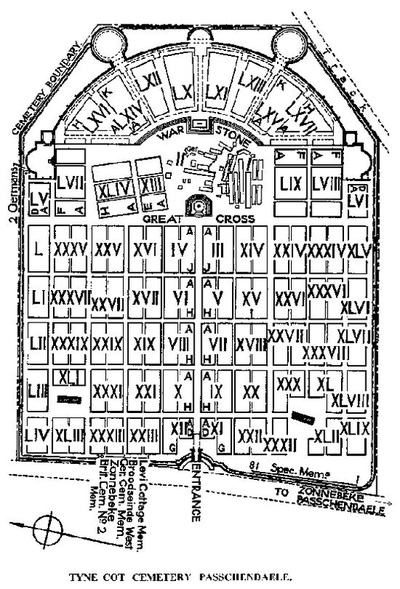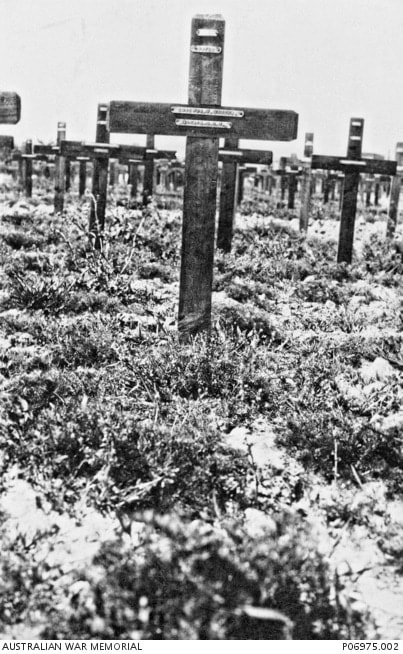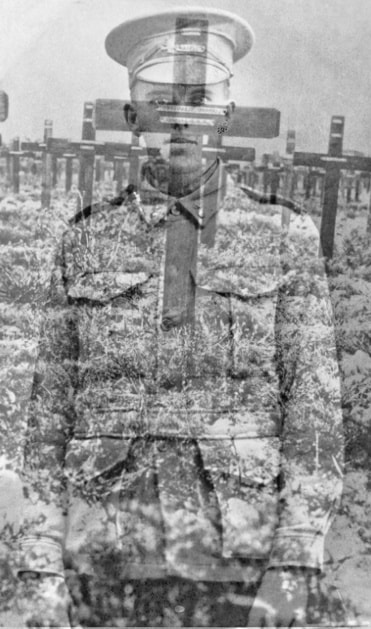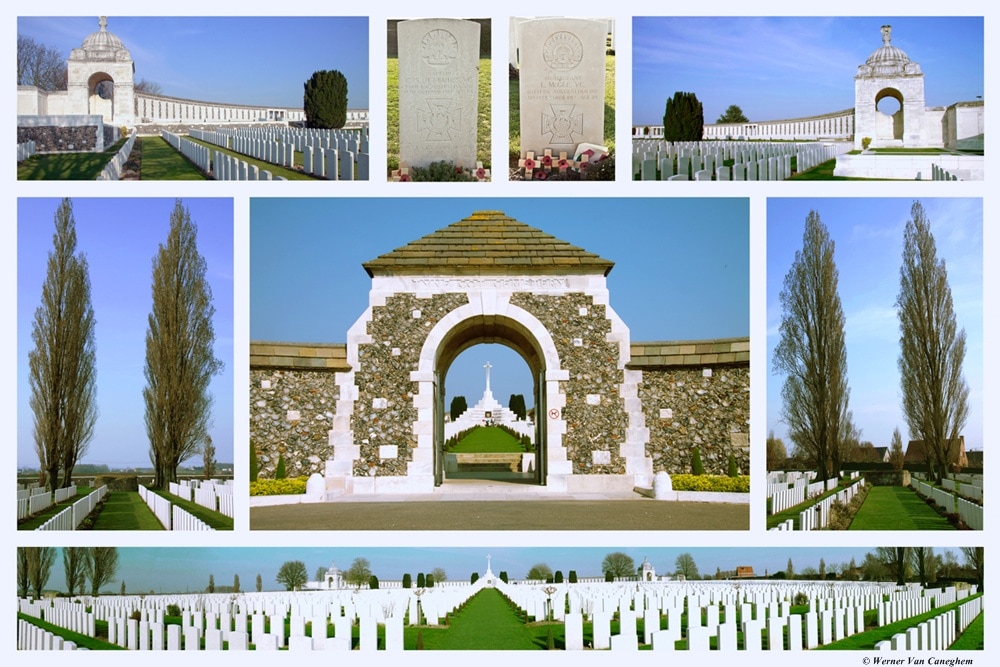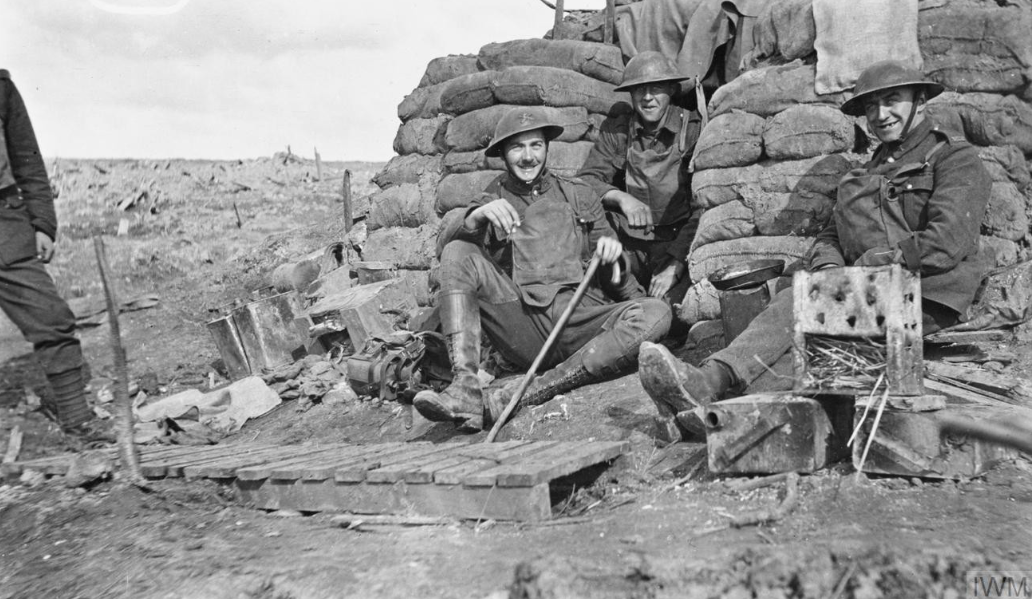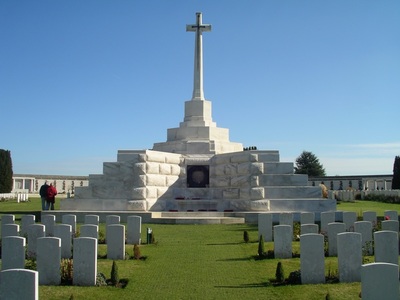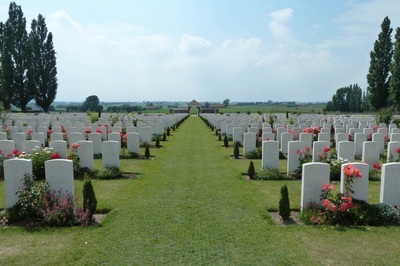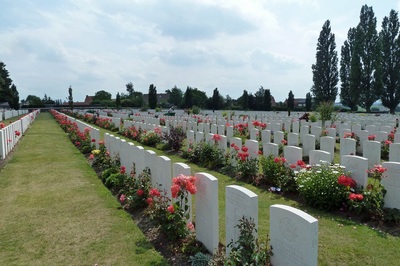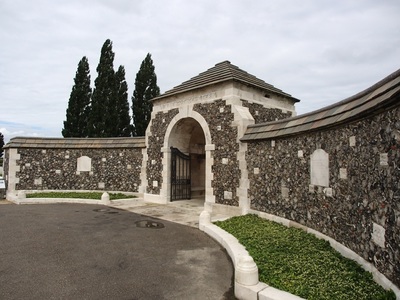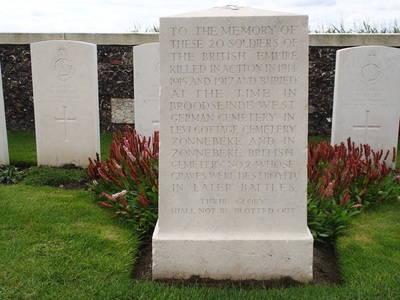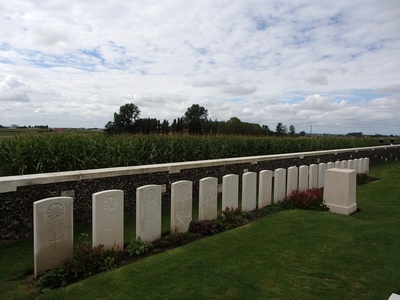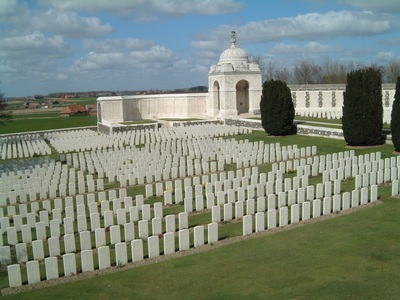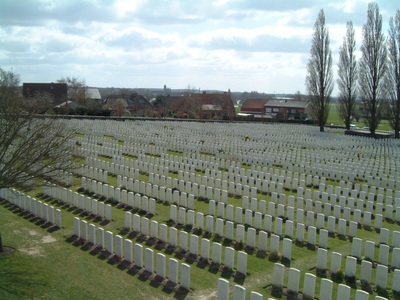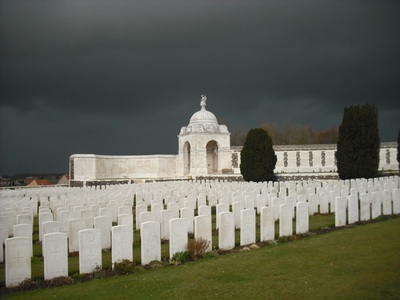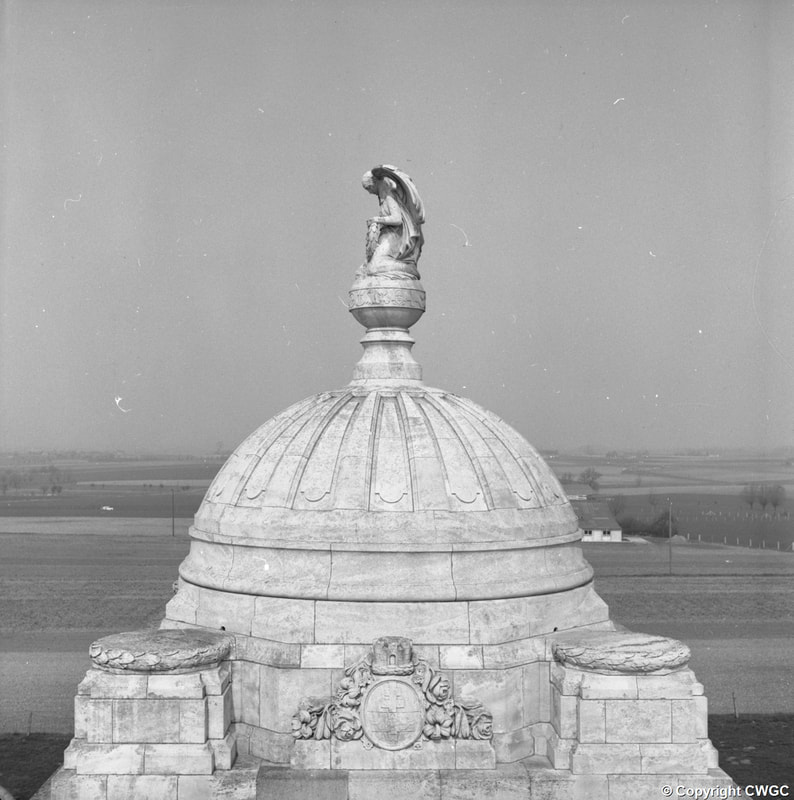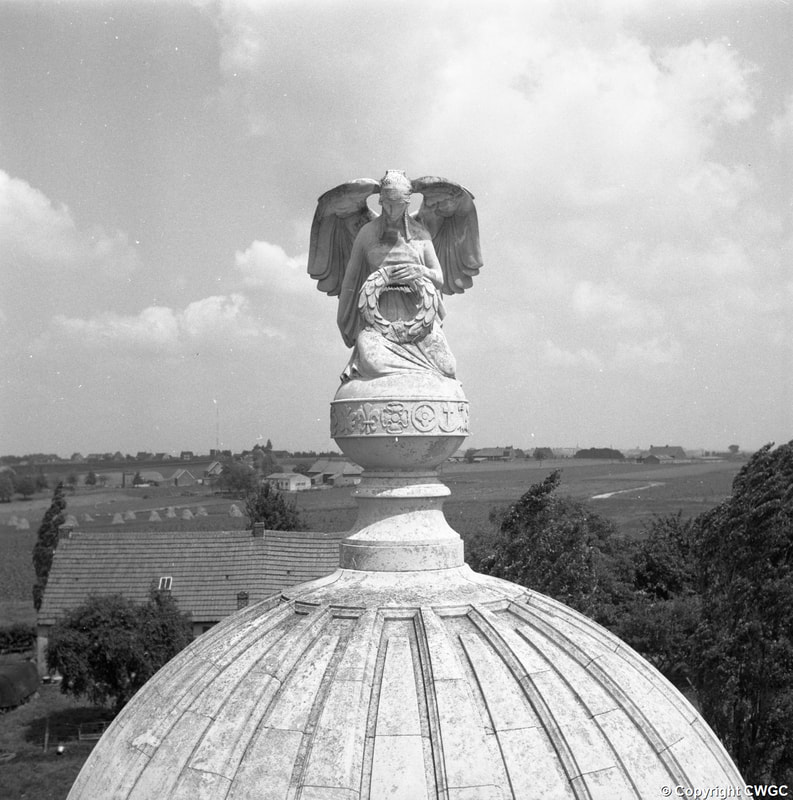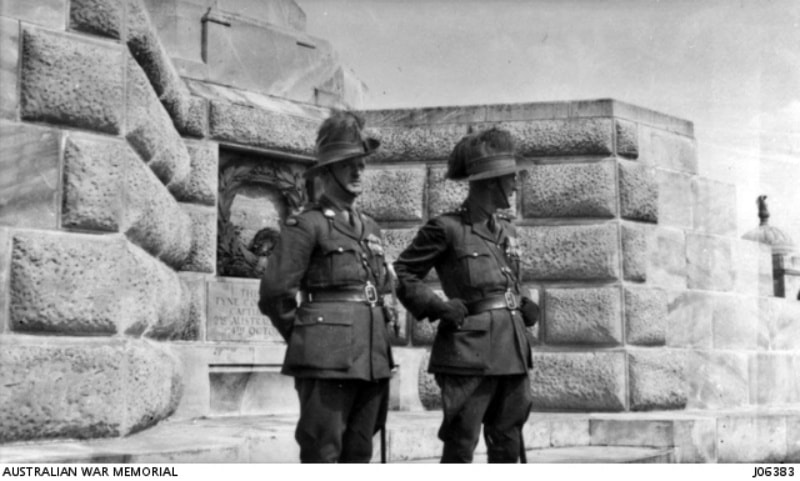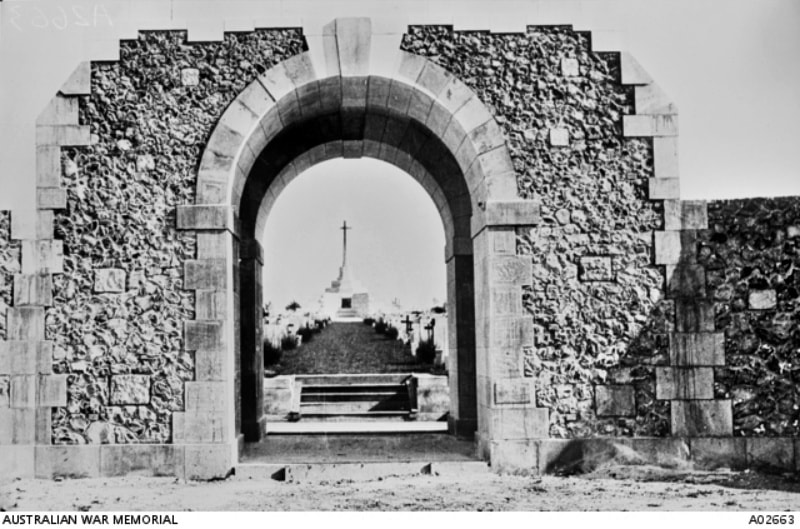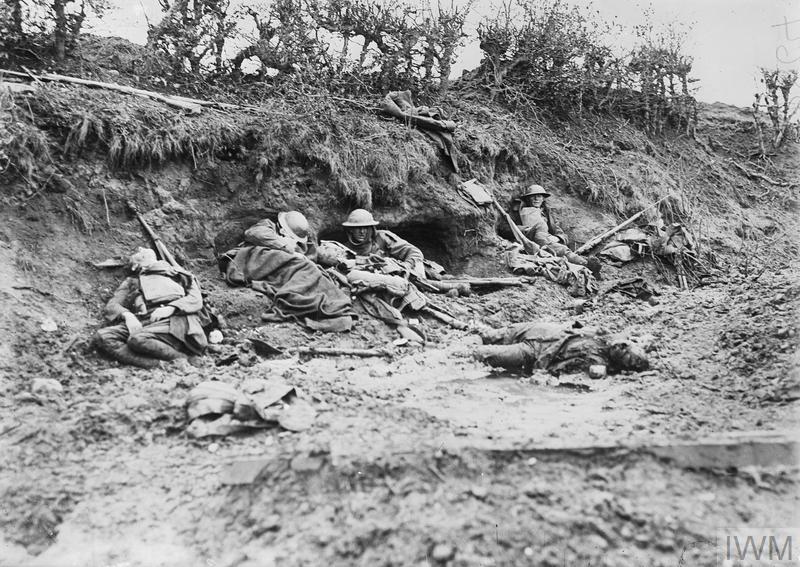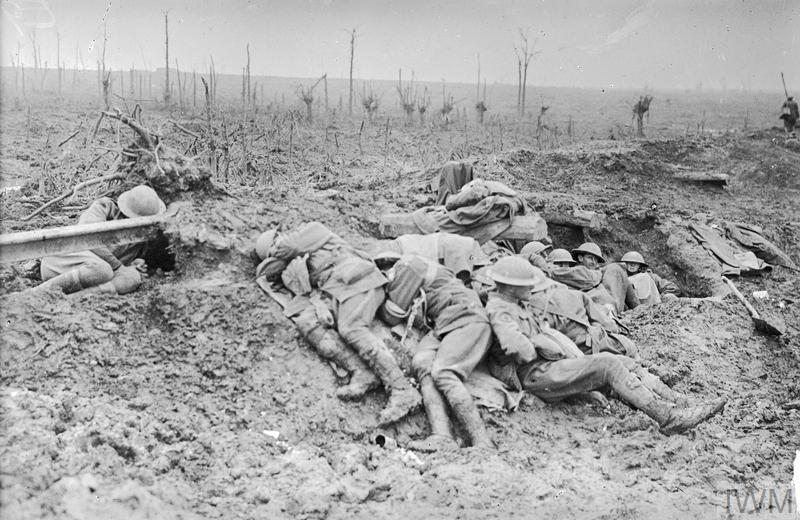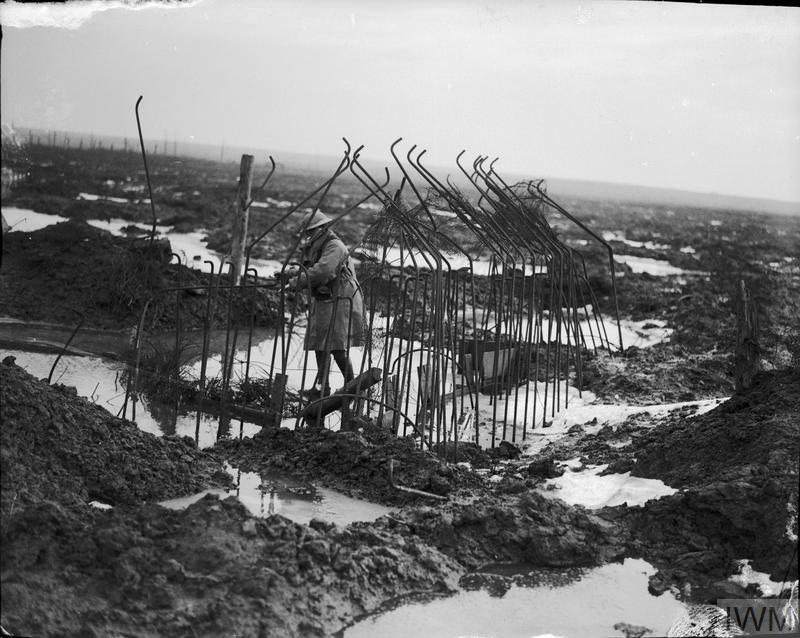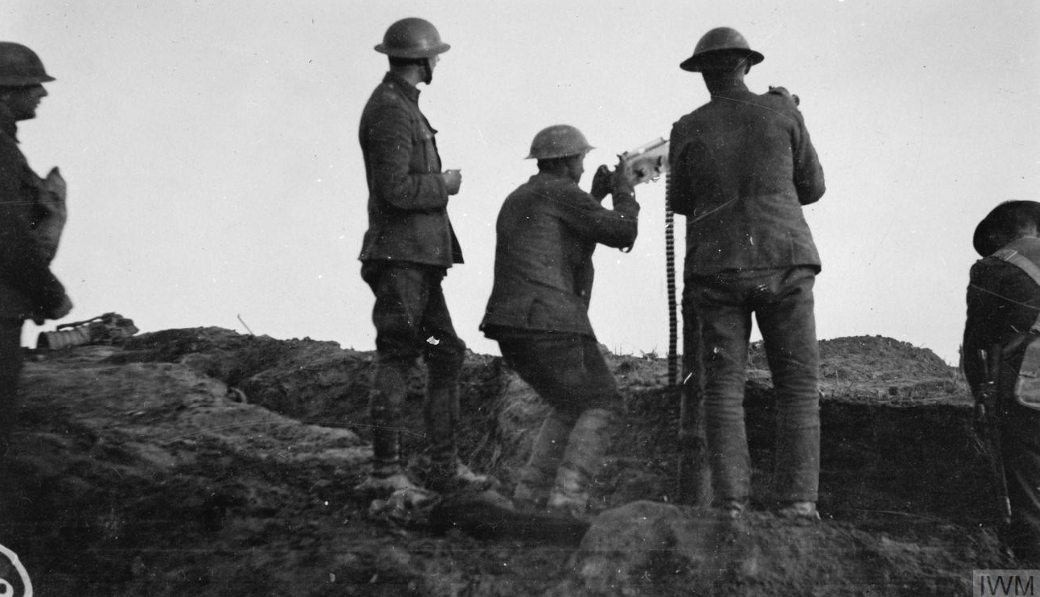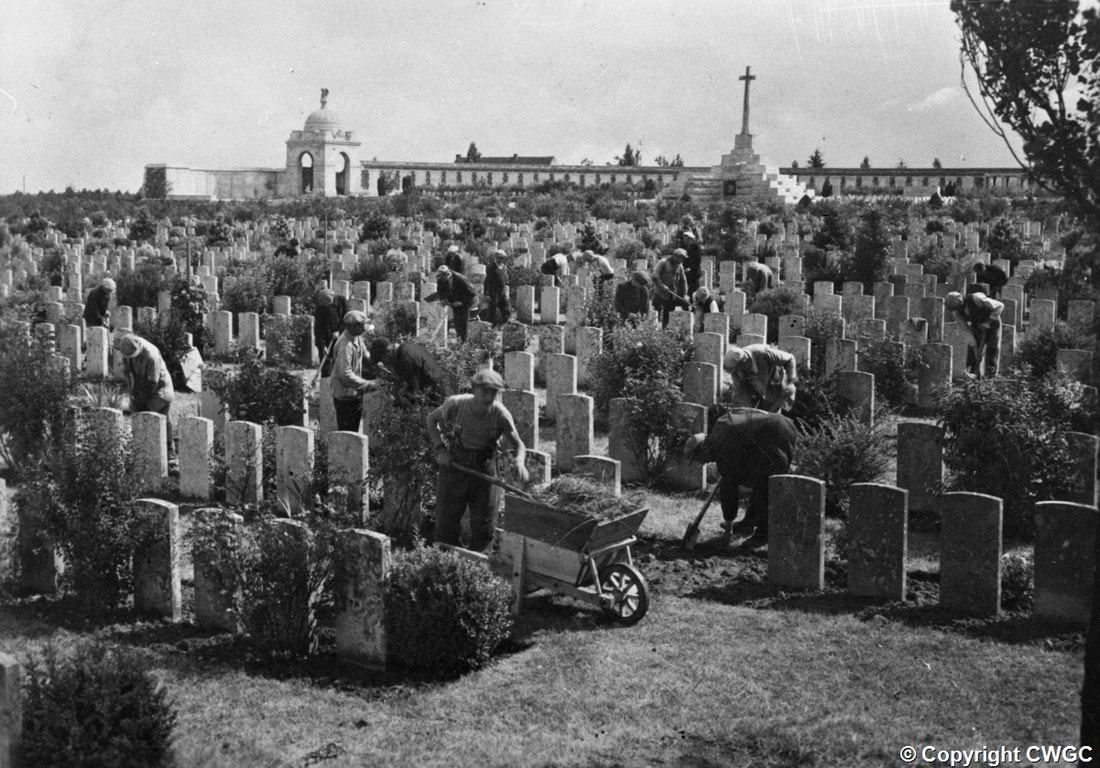TYNE COT CEMETERY
West-Vlaanderen
Belgium
GPS: Latitude 50.887279, Longitude 2.999485
Roll of Honour
Listed by Surname
Location Information
Tyne Cot Cemetery is located 9 Kms north-east of Ieper town centre, on the Tynecotstraat, a road leading from the Zonnebeekseweg (N332).
Visiting Information
There are two separate registers for this site - one for the cemetery and one for the memorial. The cemetery register will be found in the gatehouse as you enter the cemetery, and the memorial register will be found in the left hand rotunda of the memorial as you face the memorial.
Wheelchair access to this cemetery is possible via an entrance at the rear and is signposted from the car park.
Historical Information
'Tyne Cot' or 'Tyne Cottage' was the name given by the Northumberland Fusiliers to a barn which stood near the level crossing on the Passchendaele-Broodseinde road. The barn, which had become the centre of five or six German blockhouses, or pill-boxes, was captured by the 3rd Australian Division on 4 October 1917, in the advance on Passchendaele.
One of these pill-boxes was unusually large and was used as an advanced dressing station after its capture. From 6 October to the end of March 1918, 343 graves were made, on two sides of it, by the 50th (Northumbrian) and 33rd Divisions, and by two Canadian units. The cemetery was in German hands again from 13 April to 28 September, when it was finally recaptured, with Passchendaele, by the Belgian Army.
TYNE COT CEMETERY was greatly enlarged after the Armistice when remains were brought in from the battlefields of Passchendaele and Langemarck, and from a few small burial grounds, including the following:
IBERIAN SOUTH CEMETERY and IBERIAN TRENCH CEMETERY, LANGEMARCK, 1,200 metres North of Frezenberg, close to a farm called by the Army "Iberian". These contained the graves of 30 soldiers from the United Kingdom who fell in August-September, 1917, and March, 1918.
KINK CORNER CEMETERY, ZONNEBEKE, on the road to Frezenberg, containing the graves of 14 soldiers from the United Kingdom, nine from Canada and nine from Australia, who fell in September-November, 1917.
LEVI COTTAGE CEMETERY, ZONNEBEKE, near the road to Langemarck, containing the graves of ten soldiers from the United Kingdom, eight from Canada and three from Australia, who fell in September-November, 1917.
OOSTNIEUWKERKE GERMAN CEMETERY, in the village of Oostnieuwkerke, containing the graves of two soldiers from the United Kingdom.
PRAET-BOSCH GERMAN CEMETERY, VLADSLOO, in the forest on the road from Kortewilde to Leke. Here were buried six officers of the R.F.C. and R.A.F. who fell in 1917-18.
STADEN GERMAN CEMETERY, on the South-East side of the road to Stadenberg, containing the graves of 14 soldiers from the United Kingdom and ten from Canada who fell in 1915-1917.
WATERLOO FARM CEMETERY, PASSCHENDAELE, 650 metres North-East of
's Gravenstafel, containing the graves of ten soldiers from Canada, seven from the United Kingdom and two from New Zealand, who fell in 1917-18.
ZONNEBEKE BRITISH CEMETERY No.2, on the road between Zonnebeke and Broodseinde, in which the Germans buried 18 men of the 2nd Buffs and 20 of the 3rd Royal Fusiliers who fell in April, 1915.
It is now the largest Commonwealth war cemetery in the world in terms of burials. At the suggestion of King George V, who visited the cemetery in 1922, the Cross of Sacrifice was placed on the original large pill-box. There are three other pill-boxes in the cemetery.
There are now 11,964 Commonwealth servicemen of the First World War buried or commemorated in Tyne Cot Cemetery. 8,372 of the burials are unidentified but there are special memorials to more than 80 casualties known or believed to be buried among them. Other special memorials commemorate 20 casualties whose graves were destroyed by shell fire. There are 4 German burials, 3 being unidentified.
Total Burials: 11,968.
Identified Casualties: United Kingdom 2,337, Australia 582, Canada 451, New Zealand 178, South Africa 24, Germany 1. Total 3,593.
Unidentified Casualties: 8,375.
The cemetery and Memorial was designed by Sir Herbert Bakerand John Reginald Truelove
Decorative Features: Ferdinand Blundstone and Joseph Armitage
The TYNE COT MEMORIAL forms the north-eastern boundary of Tyne Cot Cemetery and commemorates 34,948 servicemen from the United Kingdom and New Zealand who died in the Ypres Salient after 16 August 1917 and whose graves are not known. The memorial stands close to the farthest point in Belgium reached by Commonwealth forces in the First World War until the final advance to victory.
Commemorated: United Kingdom 33,783, New Zealand 1,165. Total 34,948.
Tyne Cot Cemetery is located 9 Kms north-east of Ieper town centre, on the Tynecotstraat, a road leading from the Zonnebeekseweg (N332).
Visiting Information
There are two separate registers for this site - one for the cemetery and one for the memorial. The cemetery register will be found in the gatehouse as you enter the cemetery, and the memorial register will be found in the left hand rotunda of the memorial as you face the memorial.
Wheelchair access to this cemetery is possible via an entrance at the rear and is signposted from the car park.
Historical Information
'Tyne Cot' or 'Tyne Cottage' was the name given by the Northumberland Fusiliers to a barn which stood near the level crossing on the Passchendaele-Broodseinde road. The barn, which had become the centre of five or six German blockhouses, or pill-boxes, was captured by the 3rd Australian Division on 4 October 1917, in the advance on Passchendaele.
One of these pill-boxes was unusually large and was used as an advanced dressing station after its capture. From 6 October to the end of March 1918, 343 graves were made, on two sides of it, by the 50th (Northumbrian) and 33rd Divisions, and by two Canadian units. The cemetery was in German hands again from 13 April to 28 September, when it was finally recaptured, with Passchendaele, by the Belgian Army.
TYNE COT CEMETERY was greatly enlarged after the Armistice when remains were brought in from the battlefields of Passchendaele and Langemarck, and from a few small burial grounds, including the following:
IBERIAN SOUTH CEMETERY and IBERIAN TRENCH CEMETERY, LANGEMARCK, 1,200 metres North of Frezenberg, close to a farm called by the Army "Iberian". These contained the graves of 30 soldiers from the United Kingdom who fell in August-September, 1917, and March, 1918.
KINK CORNER CEMETERY, ZONNEBEKE, on the road to Frezenberg, containing the graves of 14 soldiers from the United Kingdom, nine from Canada and nine from Australia, who fell in September-November, 1917.
LEVI COTTAGE CEMETERY, ZONNEBEKE, near the road to Langemarck, containing the graves of ten soldiers from the United Kingdom, eight from Canada and three from Australia, who fell in September-November, 1917.
OOSTNIEUWKERKE GERMAN CEMETERY, in the village of Oostnieuwkerke, containing the graves of two soldiers from the United Kingdom.
PRAET-BOSCH GERMAN CEMETERY, VLADSLOO, in the forest on the road from Kortewilde to Leke. Here were buried six officers of the R.F.C. and R.A.F. who fell in 1917-18.
STADEN GERMAN CEMETERY, on the South-East side of the road to Stadenberg, containing the graves of 14 soldiers from the United Kingdom and ten from Canada who fell in 1915-1917.
WATERLOO FARM CEMETERY, PASSCHENDAELE, 650 metres North-East of
's Gravenstafel, containing the graves of ten soldiers from Canada, seven from the United Kingdom and two from New Zealand, who fell in 1917-18.
ZONNEBEKE BRITISH CEMETERY No.2, on the road between Zonnebeke and Broodseinde, in which the Germans buried 18 men of the 2nd Buffs and 20 of the 3rd Royal Fusiliers who fell in April, 1915.
It is now the largest Commonwealth war cemetery in the world in terms of burials. At the suggestion of King George V, who visited the cemetery in 1922, the Cross of Sacrifice was placed on the original large pill-box. There are three other pill-boxes in the cemetery.
There are now 11,964 Commonwealth servicemen of the First World War buried or commemorated in Tyne Cot Cemetery. 8,372 of the burials are unidentified but there are special memorials to more than 80 casualties known or believed to be buried among them. Other special memorials commemorate 20 casualties whose graves were destroyed by shell fire. There are 4 German burials, 3 being unidentified.
Total Burials: 11,968.
Identified Casualties: United Kingdom 2,337, Australia 582, Canada 451, New Zealand 178, South Africa 24, Germany 1. Total 3,593.
Unidentified Casualties: 8,375.
The cemetery and Memorial was designed by Sir Herbert Bakerand John Reginald Truelove
Decorative Features: Ferdinand Blundstone and Joseph Armitage
The TYNE COT MEMORIAL forms the north-eastern boundary of Tyne Cot Cemetery and commemorates 34,948 servicemen from the United Kingdom and New Zealand who died in the Ypres Salient after 16 August 1917 and whose graves are not known. The memorial stands close to the farthest point in Belgium reached by Commonwealth forces in the First World War until the final advance to victory.
Commemorated: United Kingdom 33,783, New Zealand 1,165. Total 34,948.
Images in this gallery © Geerhard Joos
Captain Clarence Smith Jeffries V. C.
34th Battalion Australian Infantry
killed in action on 12th October 1917 aged 23.
Plot XL. E 1.
Son of Joshua and Barbara Jeffries, of Abermain, New South Wales. Native of Wallsend, New South Wales.
His headstone bears the inscription "On Fames Eternal Camping Ground Their Silent Tents Are Spread"
Studio portrait of Lieutenant (Lt) Clarence Smith Jeffries, 34th Battalion, of Wallsend, NSW. Born on 26 October 1897, Jeffries attended Dudley Public School and the Newcastle Collegiate and High schools before being apprenticed to his father as a mining engineer. In 1912 he joined the 14th (Hunter River) Infantry Regiment as a private and was promoted sergeant a year later. Following the outbreak of the First World War he was commissioned second lieutenant on 22 August 1914. He instructed volunteers for the Australian Imperial Force at Newcastle and Liverpool camps, becoming a lieutenant in July 1915. On 1 February 1916 Jeffries, then in charge of the Abermain Collieries surveying department, was appointed second lieutenant in the 34th Battalion, and embarked for England. In August he was promoted lieutenant and in November his battalion moved to the Western Front where he was promoted captain on 26 June. On 12 October 1917, in the attack on Passchendaele during the third phase of the battle of Ypres, his company's advance towards its first objective was held up by two pill-boxes. He organised and led a bombing party which eliminated the obstacle and captured thirty-five prisoners and four machine-guns. He then led his company forward, under an extremely heavy enemy artillery barrage and enfilade machine-gun fire, to the objective. Later that morning the battalion's advance to its second objective was delayed by a machine-gun post. Jeffries led another party to capture the position, enabling the advance to continue, but was killed during the operation. For his service that day he was posthumously awarded the Victoria Cross, for 'most conspicuous bravery in attack'. Jeffries was buried near Passchendaele, in the Tyne Cot military cemetery. He is also commemorated by the Jeffries-Currey Memorial Library at Dudley Public School where William Currey, VC, had also been a pupil.
Citation
An extract from "The London Gazette," No. 30433, dated 18th Dec., 1917, records the following:-"For most conspicuous bravery in attack, when his company was held up by enemy machine-gun fire from concrete emplacements. Organising a party, he rushed one emplacement, capturing four machine guns and thirty-five prisoners. He then led his company forward under extremely heavy enemy artillery barrage and enfilade machine-gun fire to the objective. Later, he again organised a successful attack on a machine-gun emplacement, capturing two machine guns and thirty more prisoners. This gallant officer was killed during the attack, but it was entirely due to his bravery and initiative that the centre of the attack was not held up for a lengthy period. His example had a most inspiring influence."
Headstone & Portrait
456 Sergeant Lewis McGee V. C.
40th Battalion Australian Infantry
killed in action 12th October 1917, aged 29.
Plot XX. D 1.
Son of John and Mary McGee, of Ross, Tasmania; husband of Eileen Rose McGee, of Avoca, Tasmania.
Citation
An extract from "The London Gazette" No. 30400, dated 23rd Nov., 1917, records the following:- "For most conspicuous bravery when, in the advance to the final objective, Serjt. McGee led his platoon with great dash and bravery, though strongly opposed, and under heavy shell fire. His platoon was suffering severely and the advance of the Company was stopped by machine gun fire from a ' Pill-box ' post. Single-handed Serjt. McGee rushed the post armed only with a revolver. He shot some of the crew and captured the rest, and thus enabled the advance to proceed. He re-organised the remnants of his platoon and was foremost in the remainder of the advance, and during consolidation of the position he did splendid work. This Non-commissioned Officer's coolness and bravery were conspicuous and contributed largely to the success of the Company's operations. Serjt McGee was subsequently killed in action.
Headstone & Original Grave Marker
552665 Private James Peter Robertson V. C.
27th (Manitoba) Battalion Canadian Infantry
killed in action 6th November 1917, aged 35.
Plot LVIII. D. 26.
Son of Alexander and Janet Robertson, of 656, 5th St., South East, Medicine Hat, Alberta.
His headstone bears the inscription "Behold How good And How Pleasant It Is For Brethren To Dwell Together In Unity" Mother
Citation
An extract from "The London Gazette" No. 30471, dated 8th Jan., 1918, records the following:-"For most conspicuous bravery and outstanding devotion to duty in attack. When his platoon was held up by uncut wire and a machine gun causing many casualties, Pte. Robertson dashed to an opening on the flank, rushed the machine gun and, after a desperate struggle with the crew, killed four and then turned the gun on the remainder, who, overcome by the fierceness of his onslaught, were running towards their own lines. His gallant work enabled the platoon to advance. He inflicted many more casualties among the enemy, and then carrying the captured machine gun, he led his platoon to the final objective. He there selected an excellent position and got the gun into action, firing on the retreating enemy who by this time were quite demoralised by the fire brought to bear on them. During the consolidation Pte. Robertson's most determined use of the machine gun kept down the fire of the enemy snipers; his courage and his coolness cheered his comrades and inspired them to the finest efforts. Later, when two of our snipers were badly wounded in front of our trench, he went out and carried one of them in under very severe fire. He was killed just as he returned with the second man."
Headstone
Images in this gallery © Geerhard Joos
Images in this gallery © Werner Van Caneghem
c1918: Original grave marker of 1391 Private (Pte) Frank Edward Gosson, 33rd Battalion, of Macksville, NSW, at Tyne Cot Cemetery, Belgium. A labourer before enlisting in May 1916, Pte Gosson left Australia for England with the 3rd Reinforcements of the 1st Light Trench Mortar Battery in October 1916. After transferring to the 18th Battalion in February 1917, he was again transferred to the 33rd Battalion in August 1917. He was asleep in a shell hole during a heavy bombardment on Passchendaele Ridge on the 14 October 1917 when a shell landed directly on his position, killing him instantly, aged 22. Pte Gosson's younger brother, QX3391 Lance Corporal George Percy Gosson served with the 2/1st Headquarters Guard Battalion in the Second World War. He was captured by Japanese forces at Singapore and died of illness in Siam in June 1943, aged 41.
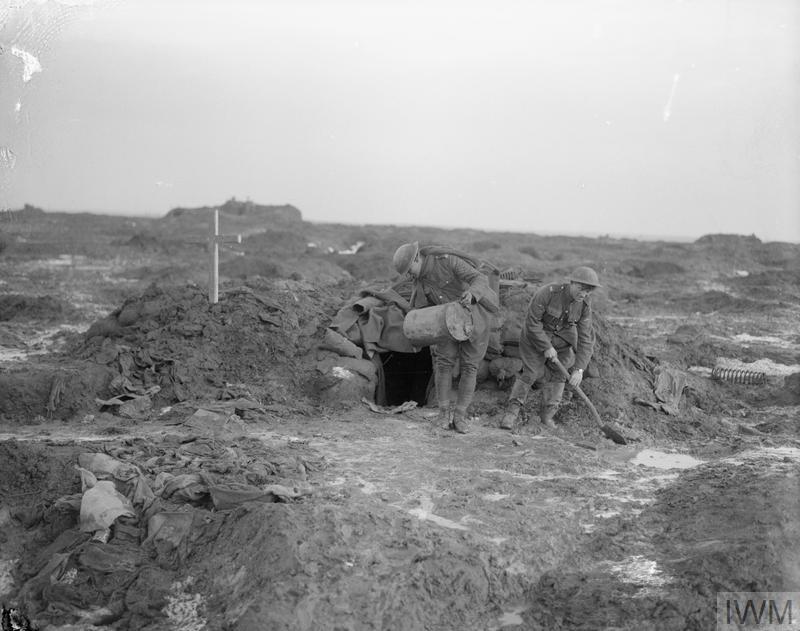
Men from the Royal Garrison Artillery outside their dug-out at Waterloo Farm, near Broodseinde, 11 January 1918. The ground surrounding the dug-out is waterlogged and shell-marked, indications of the heavy fighting and subsequent bad weather in the area. A war grave rests beside the dug-out. © IWM Q 8427

